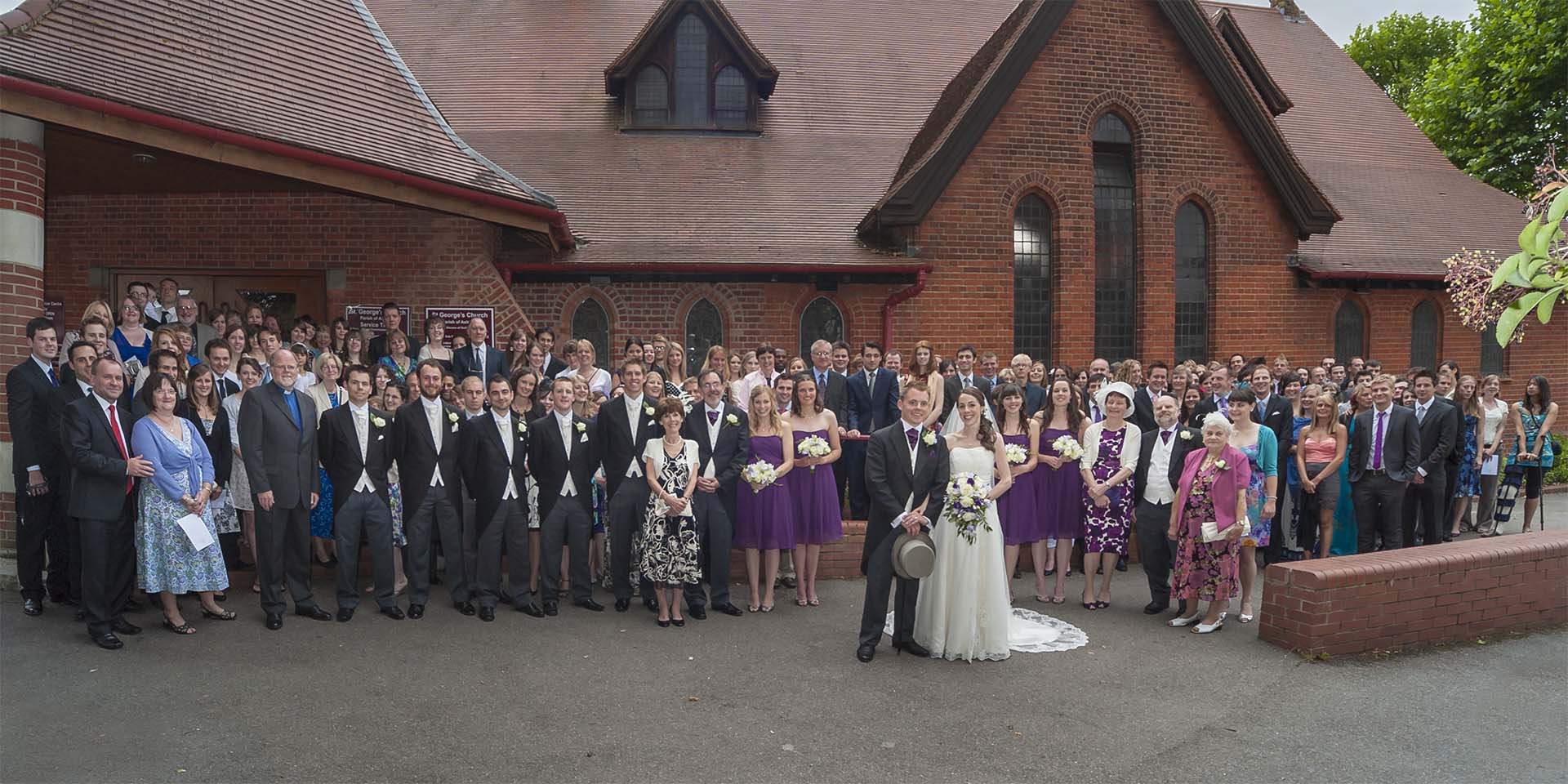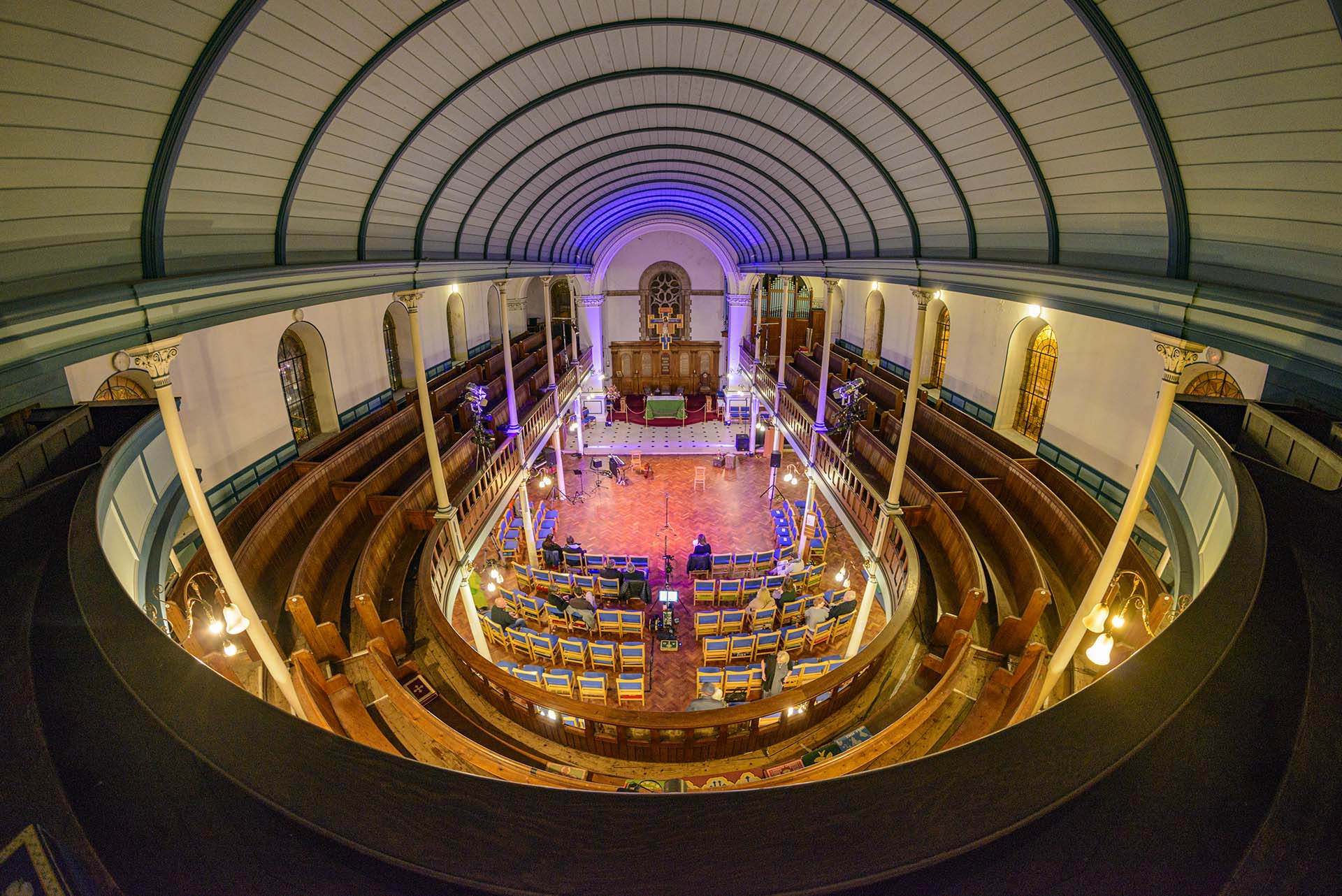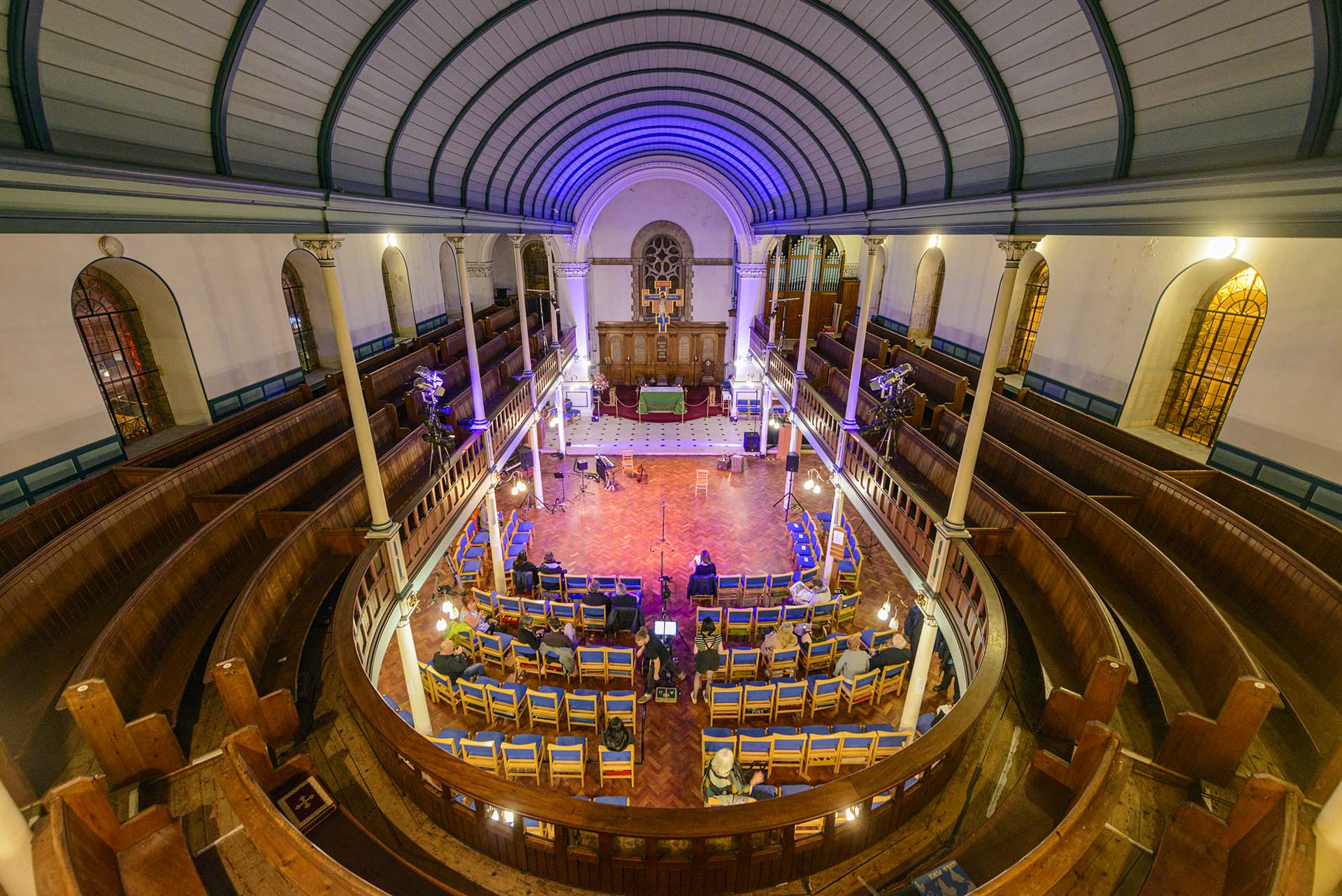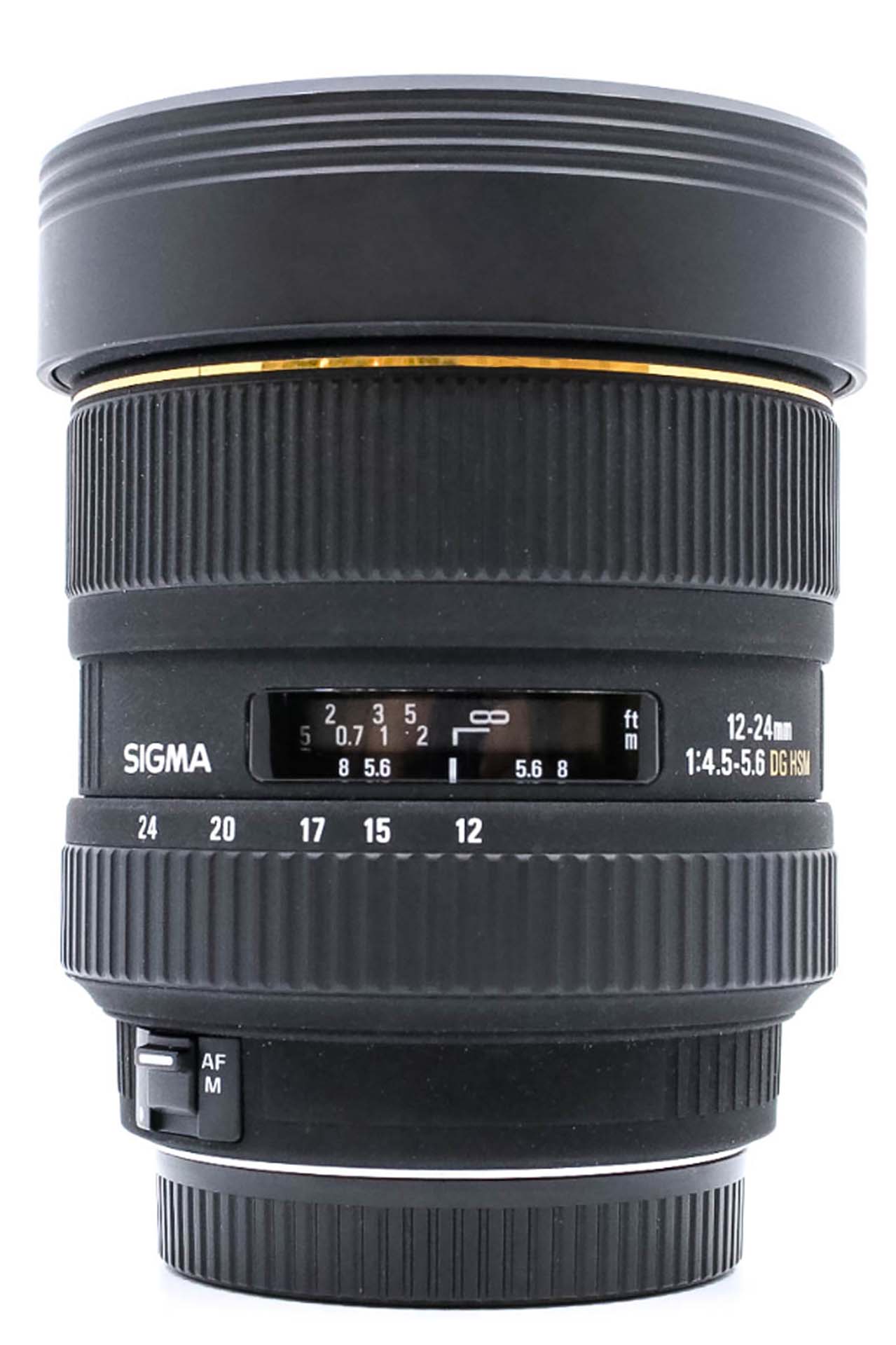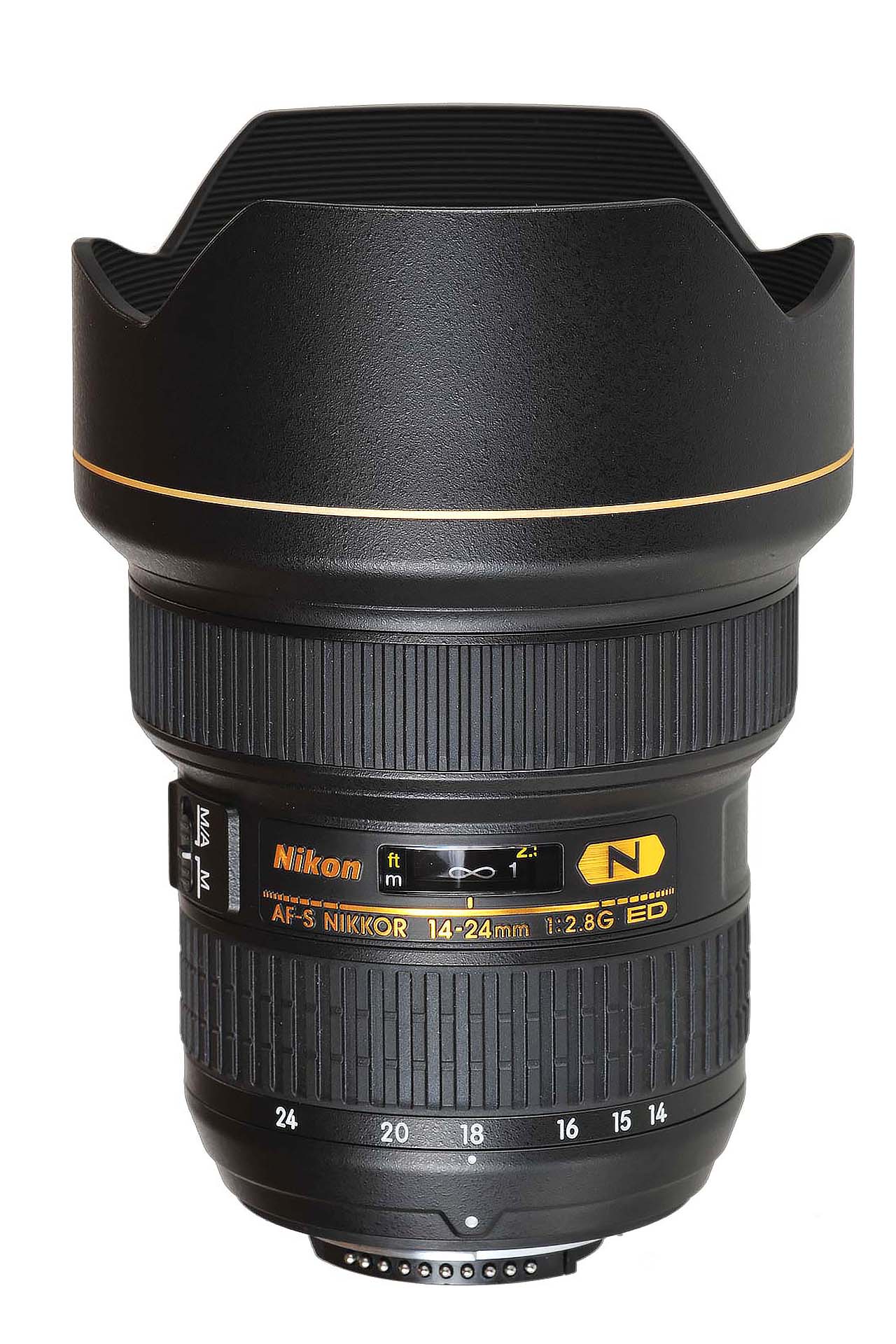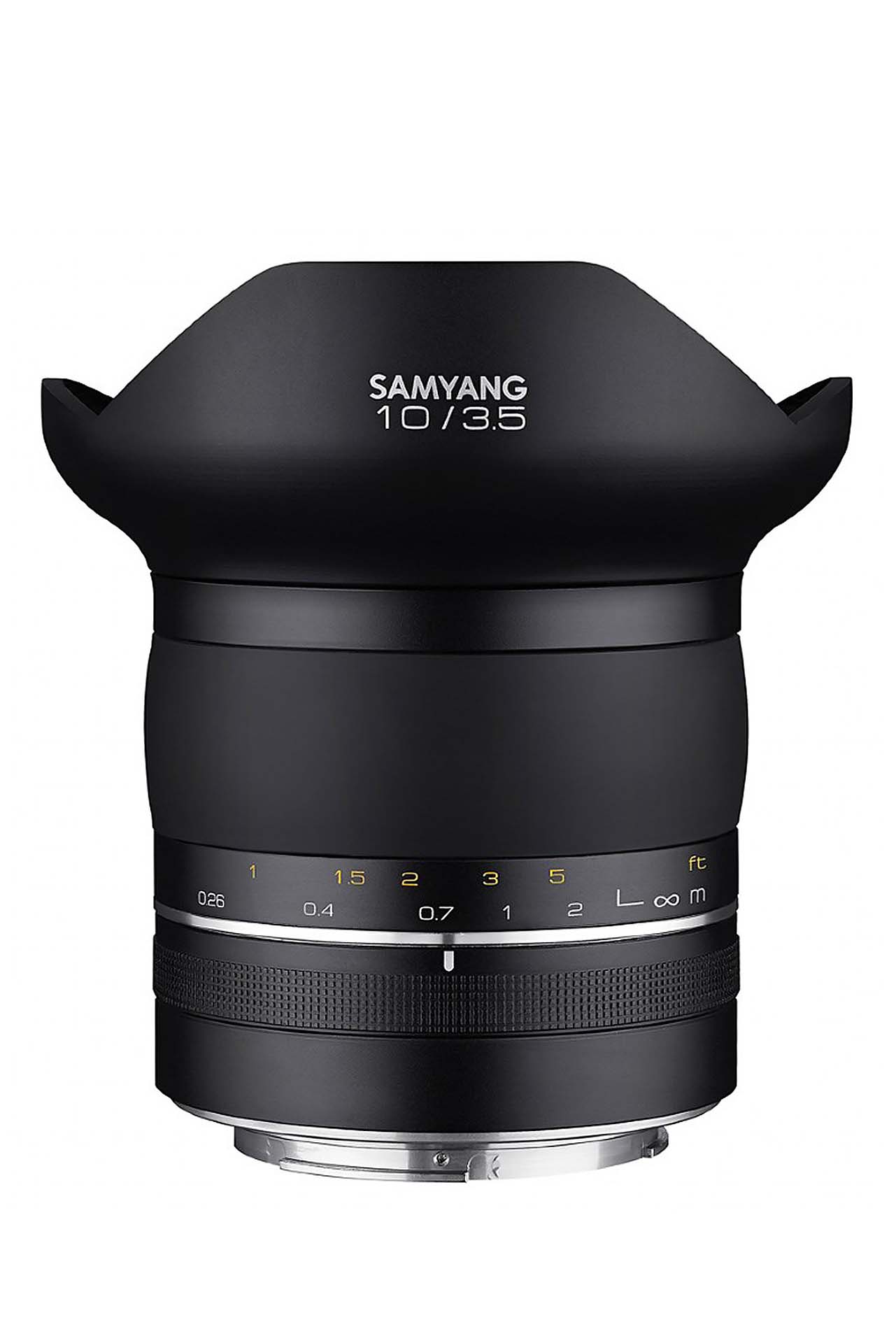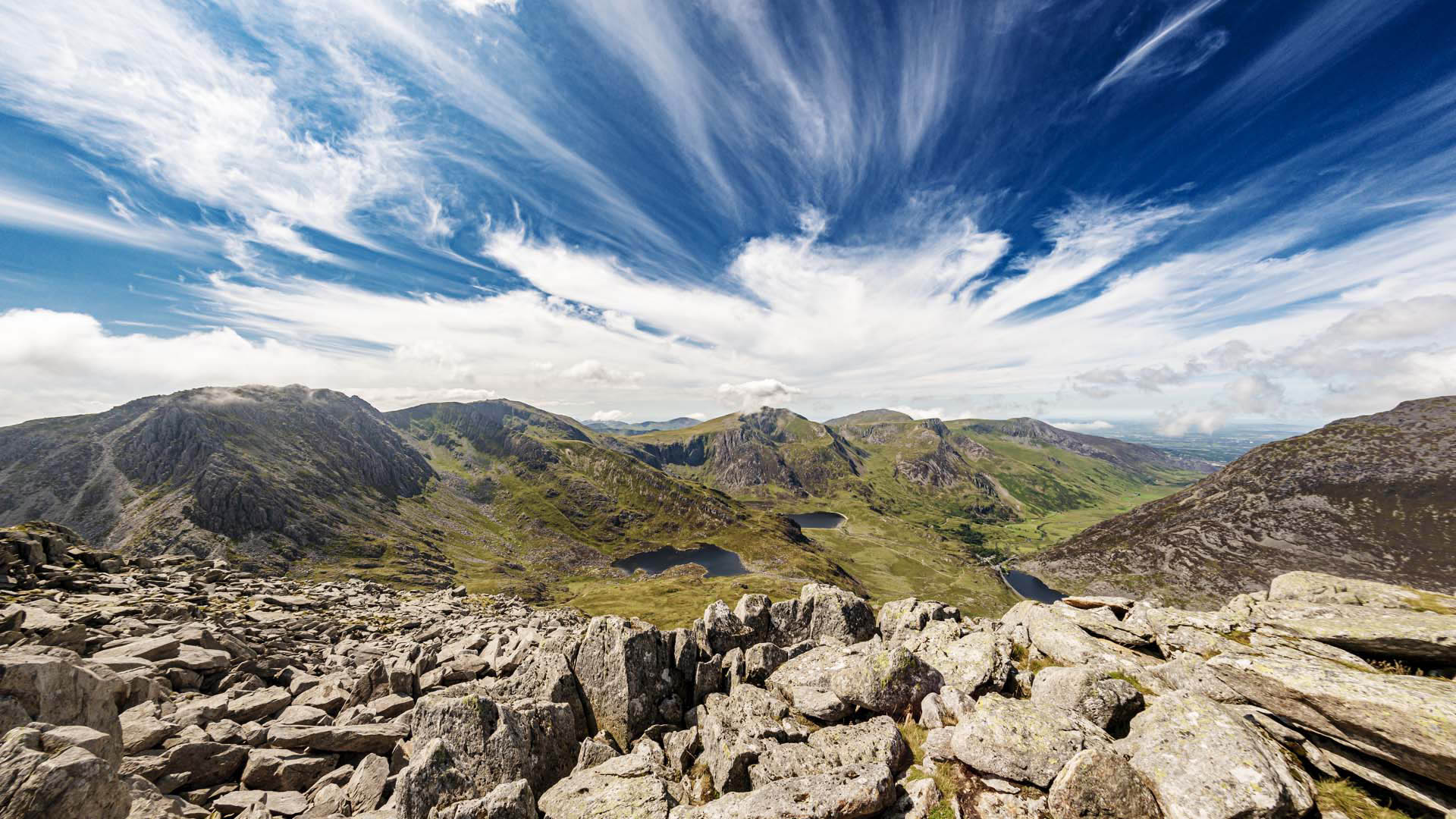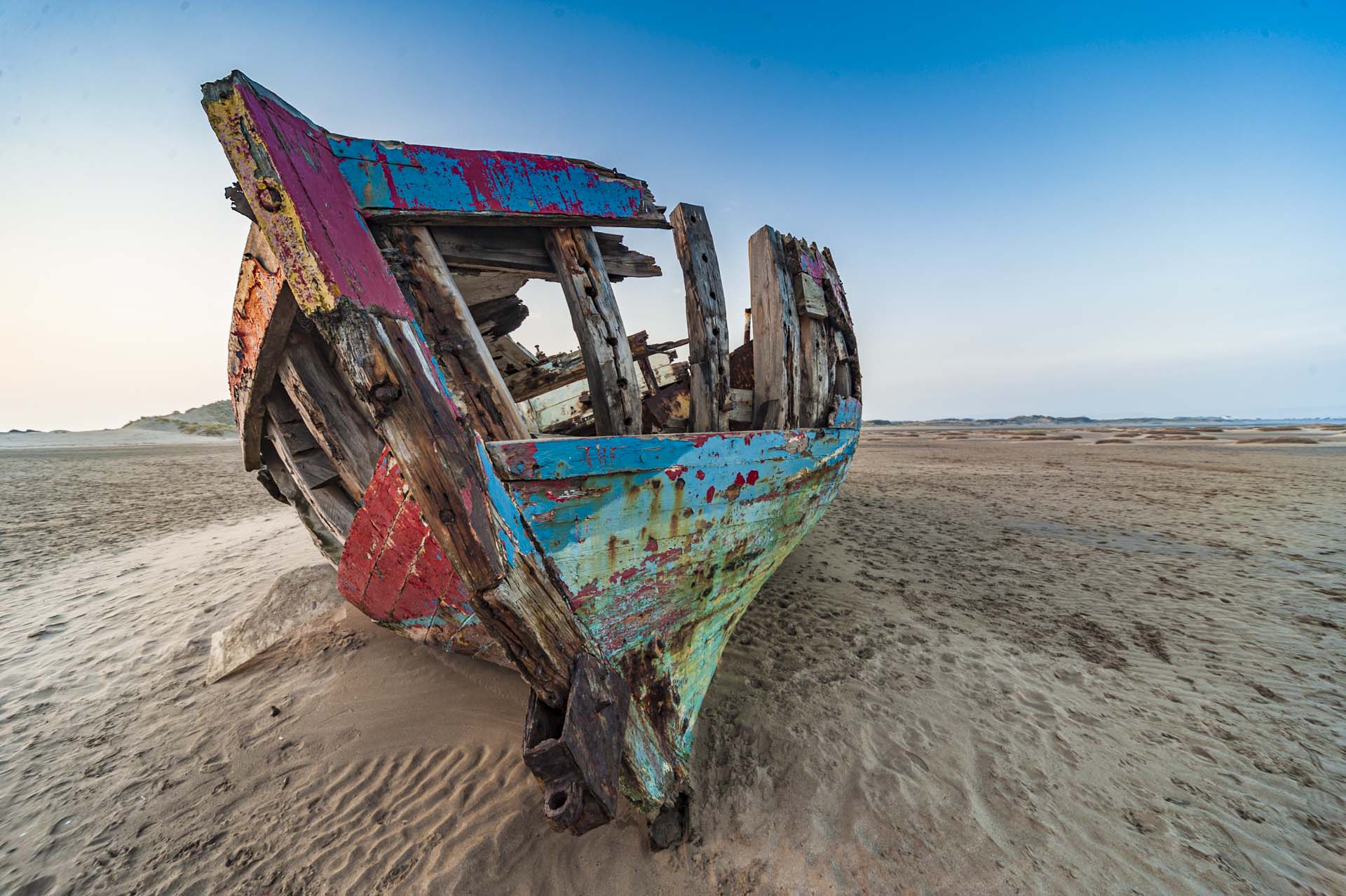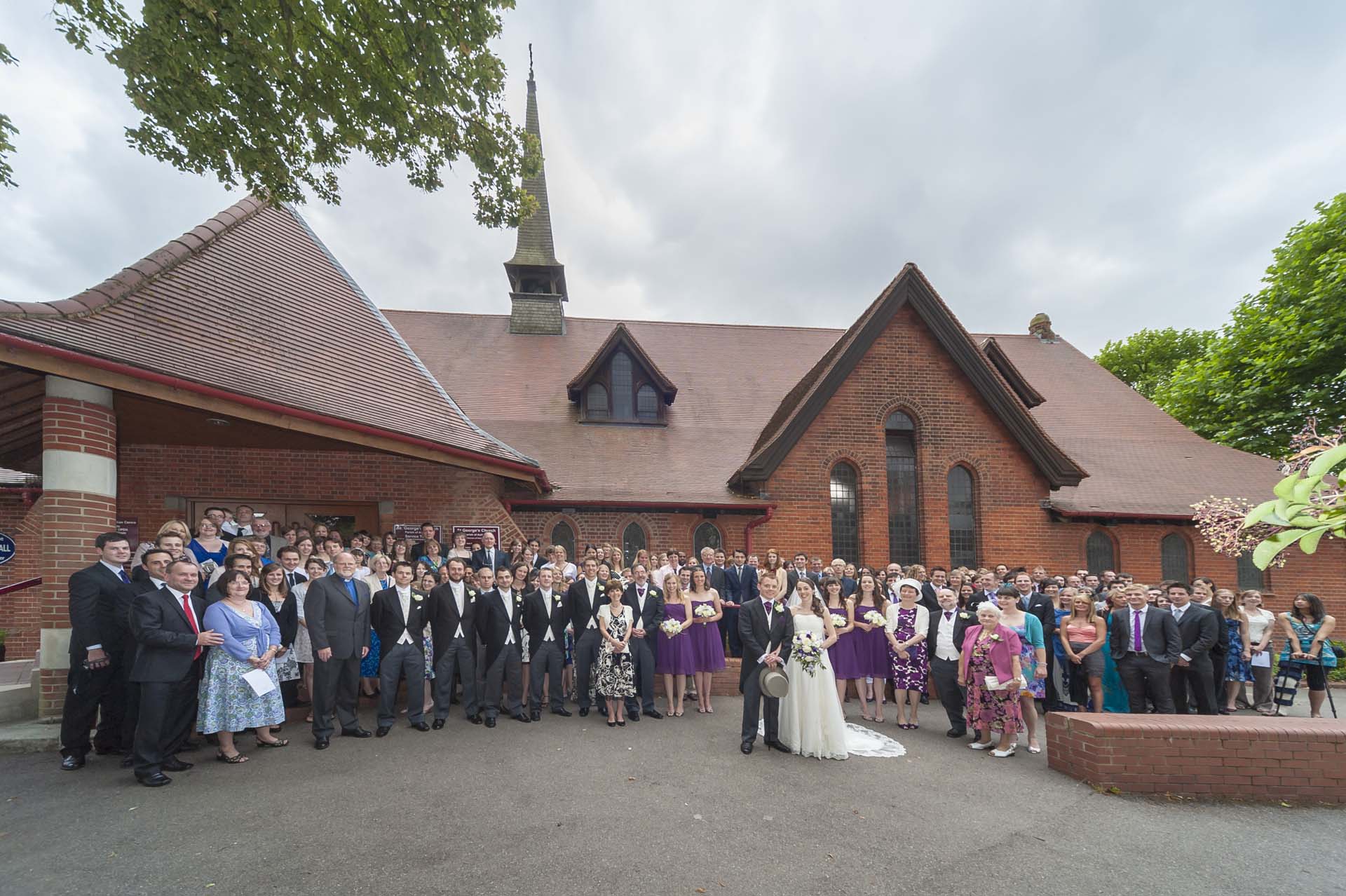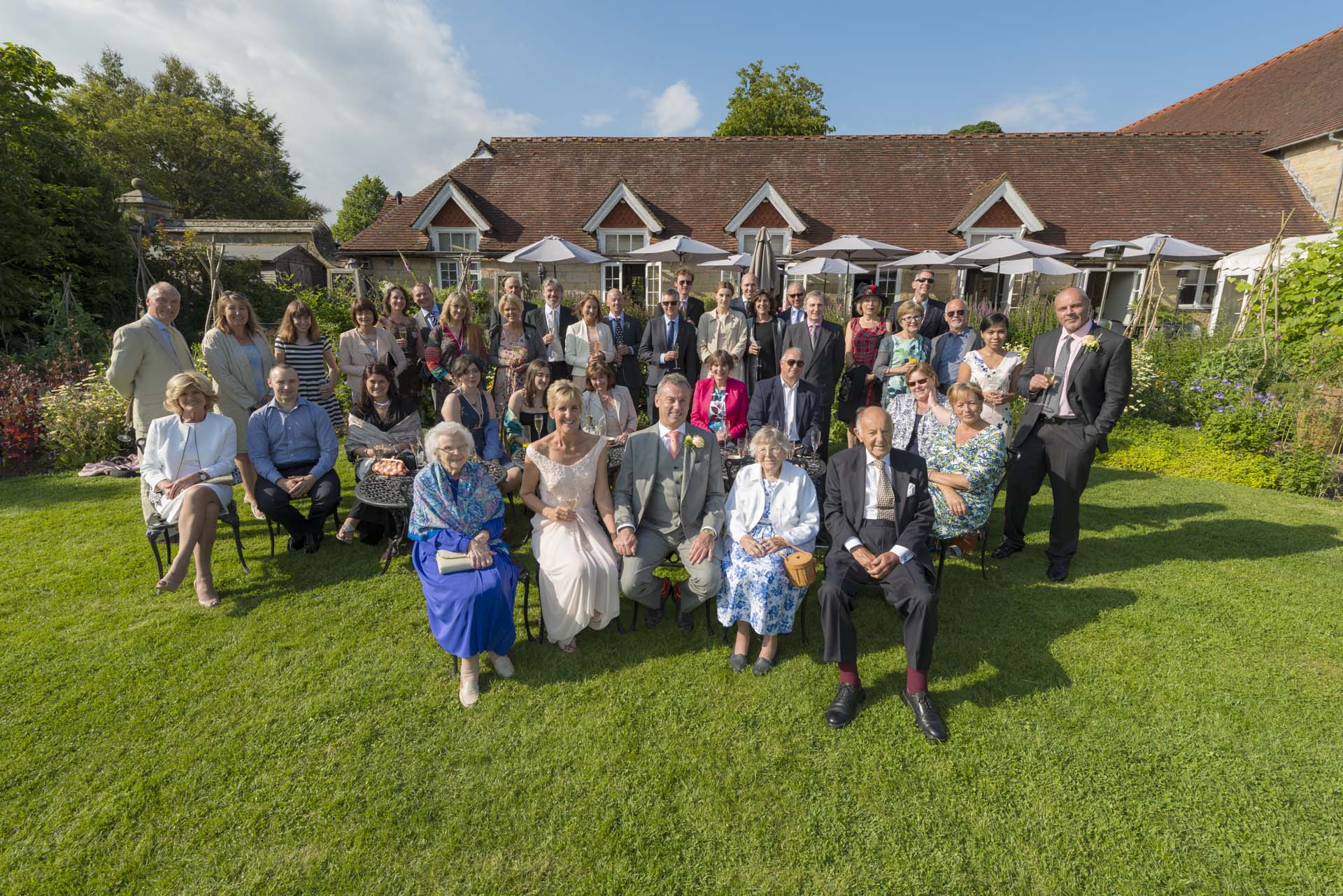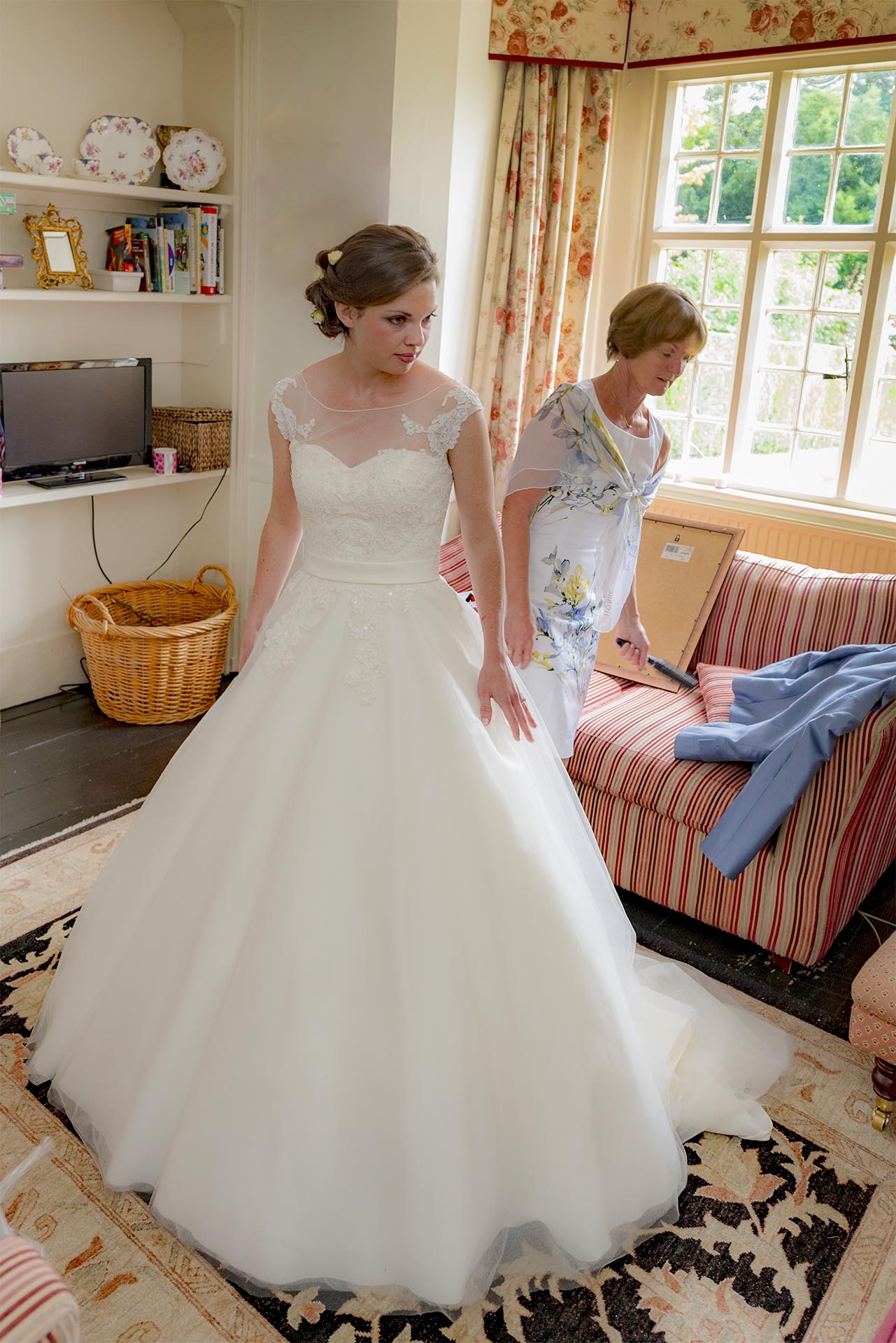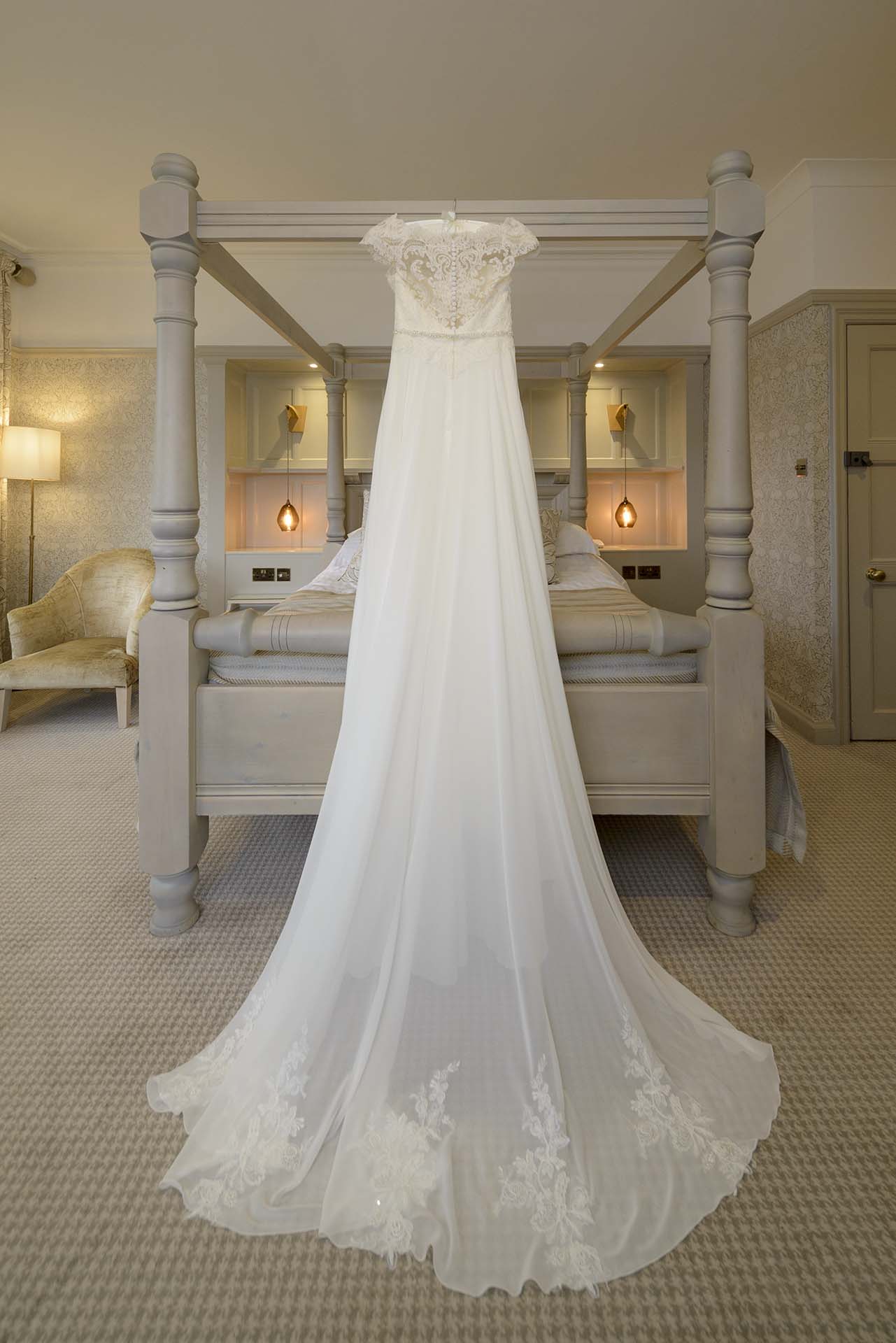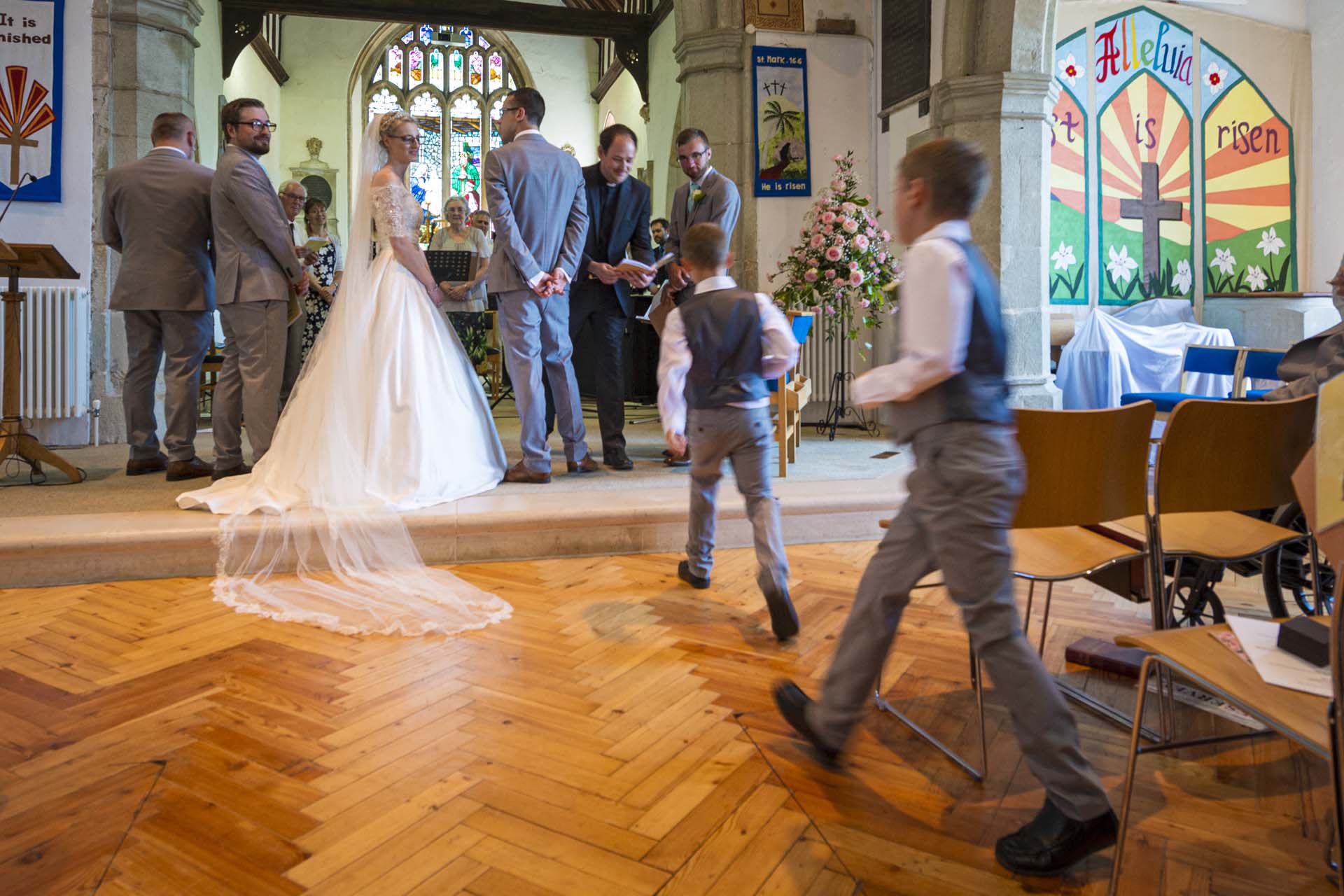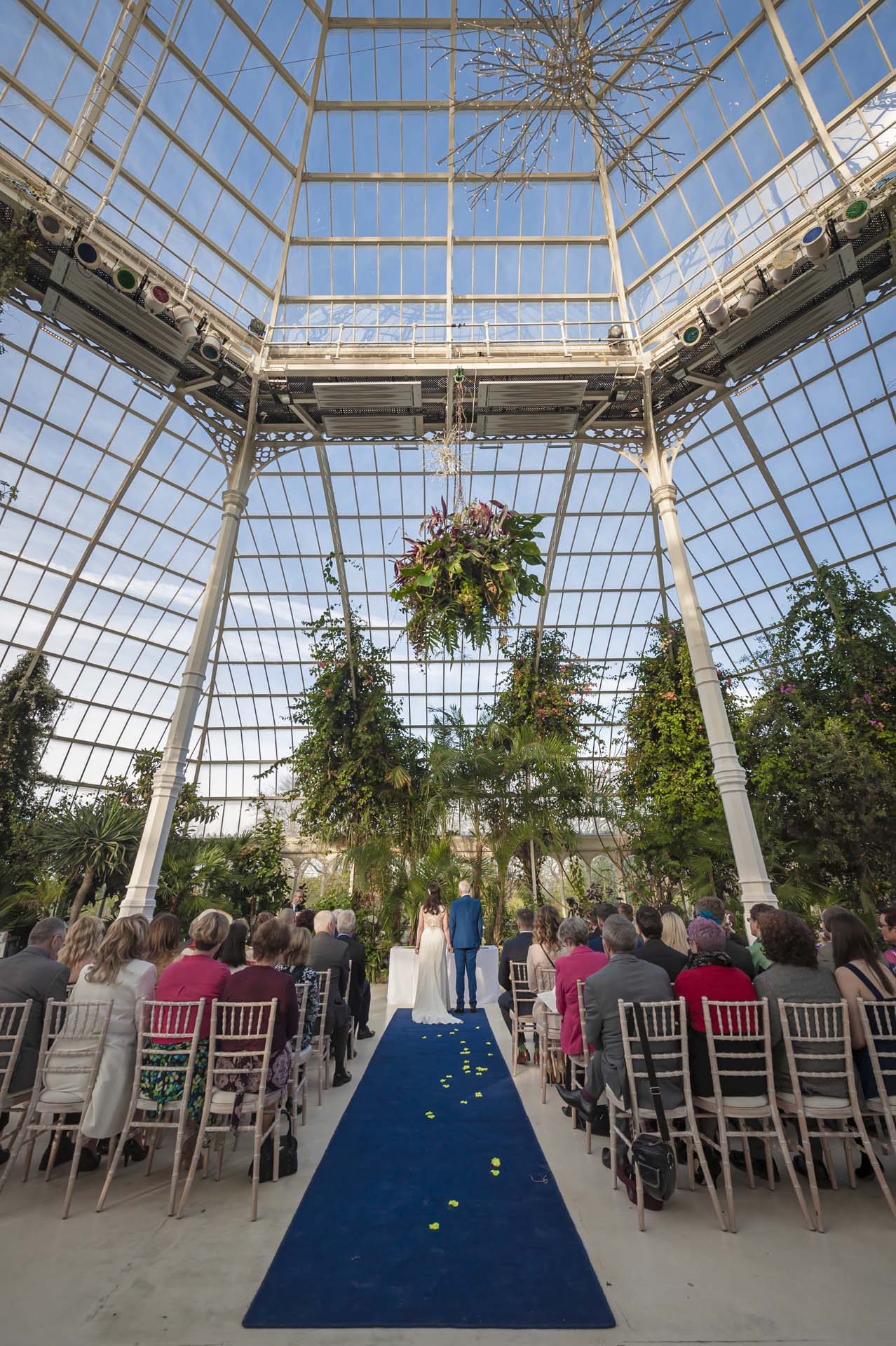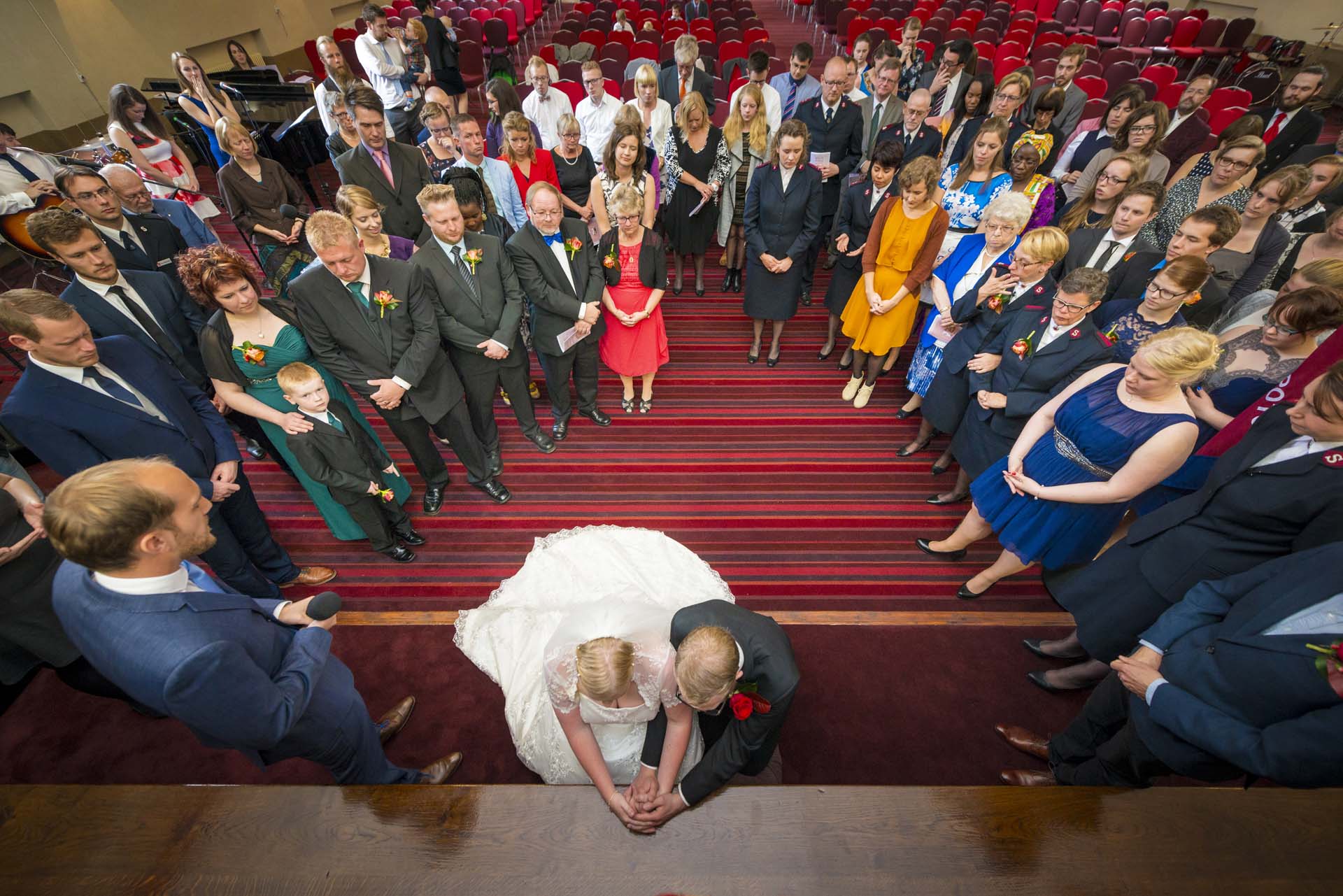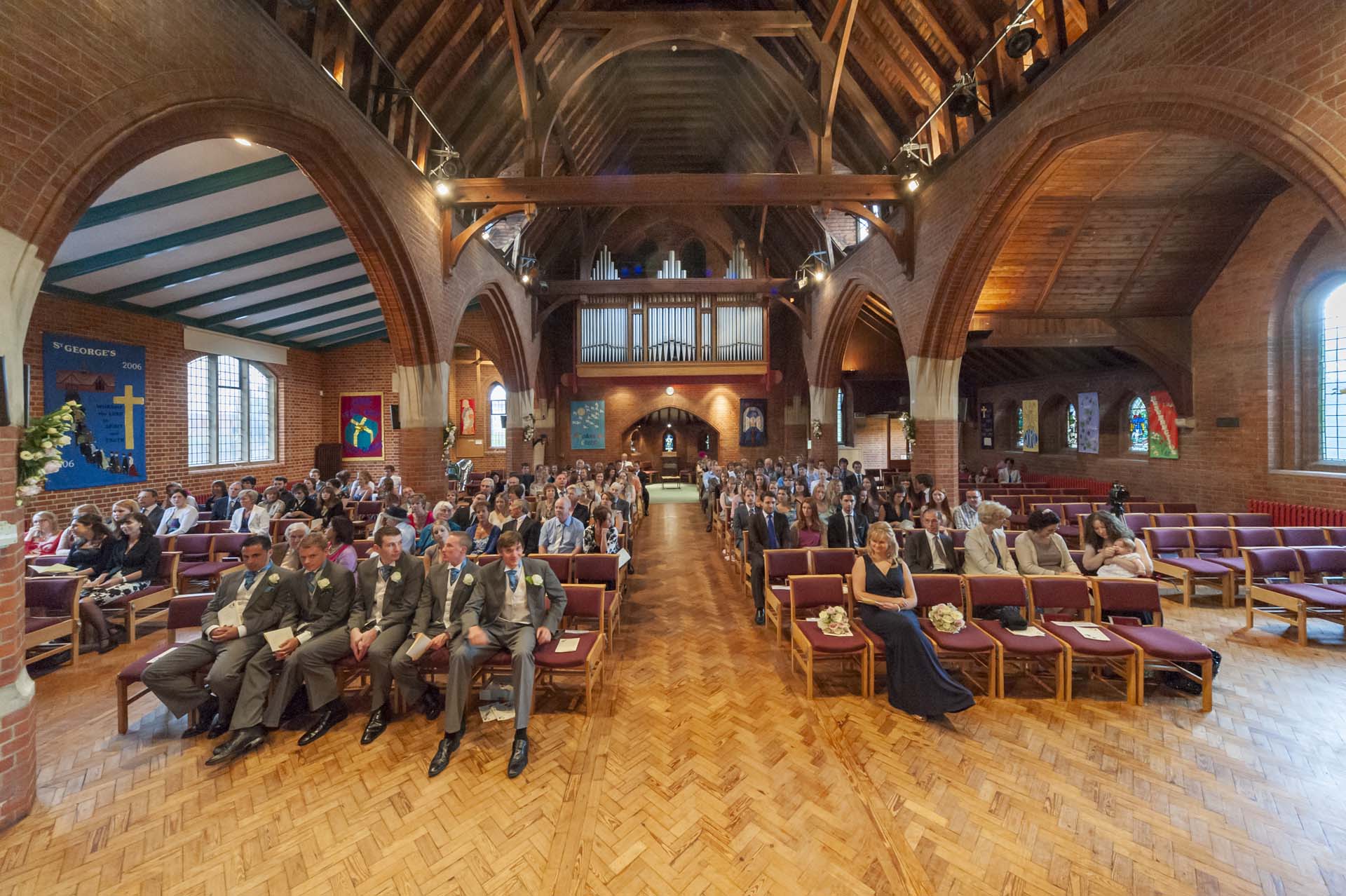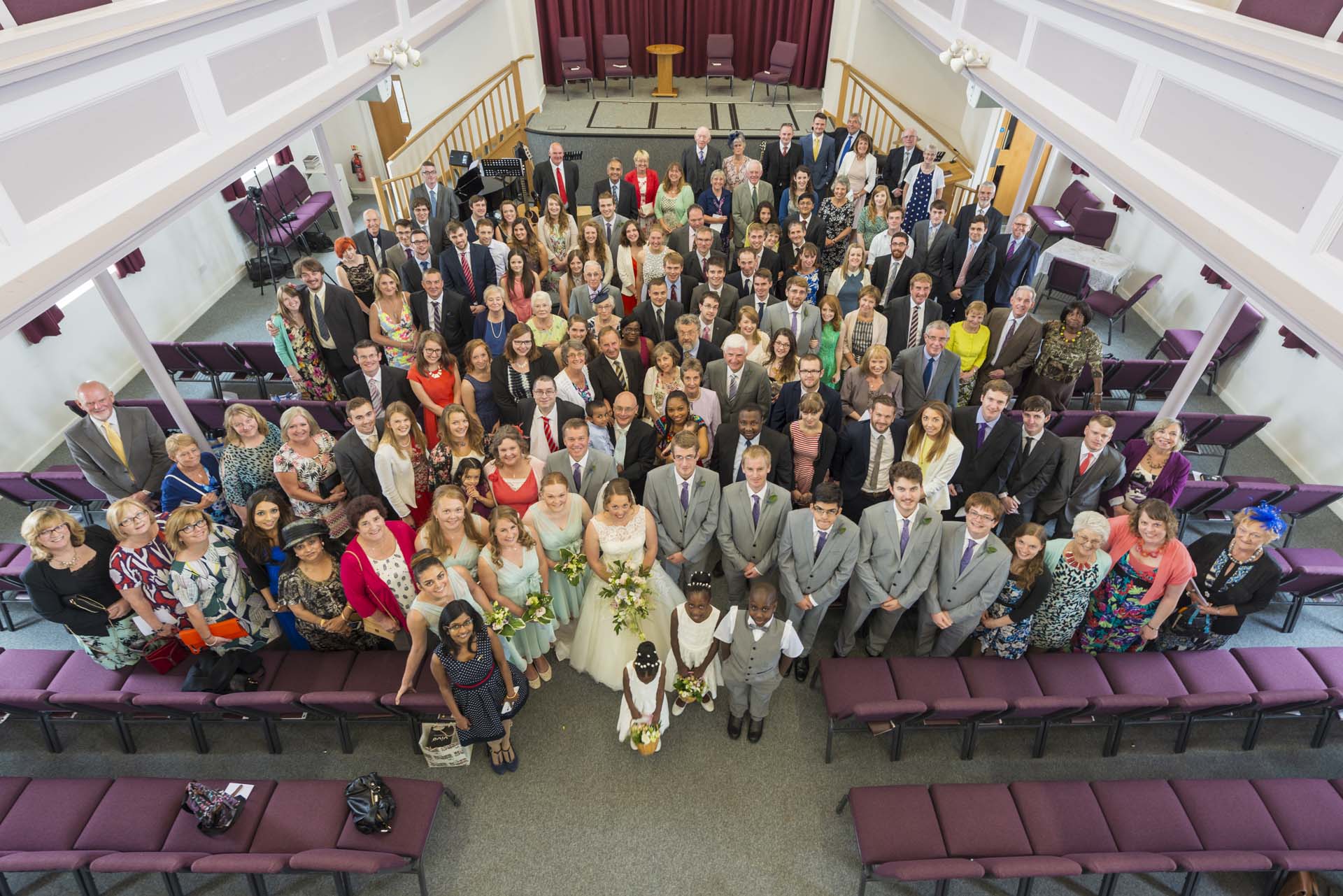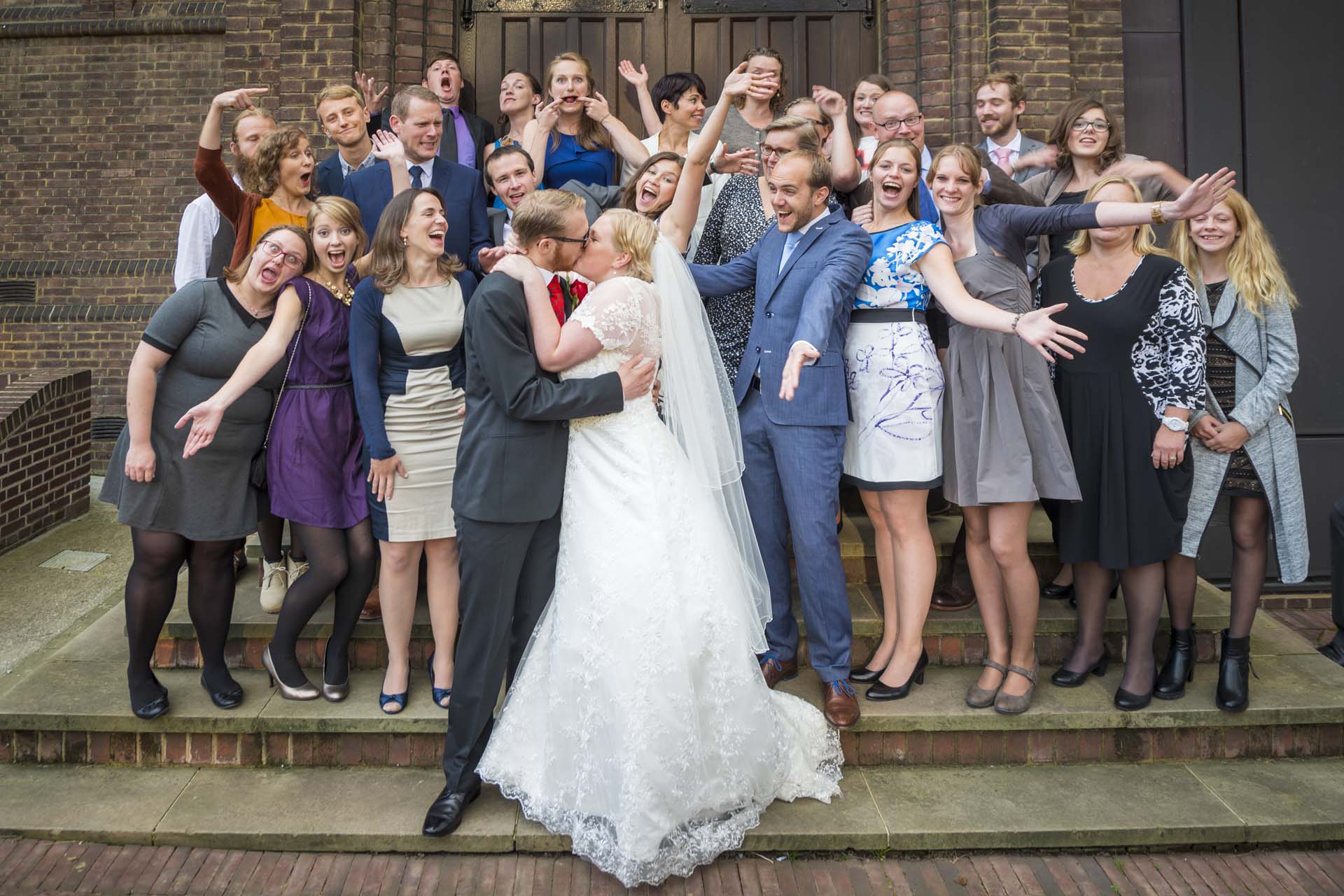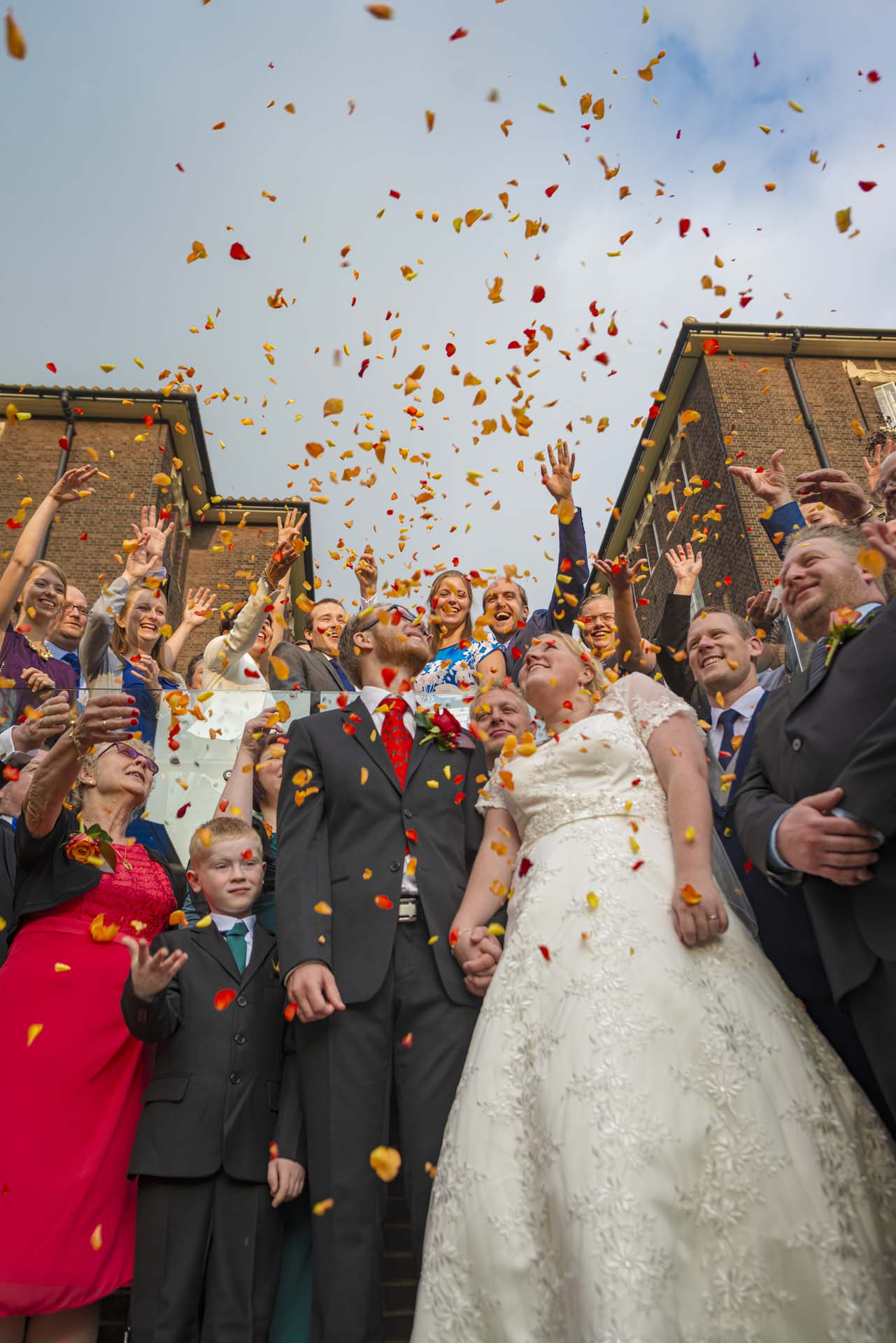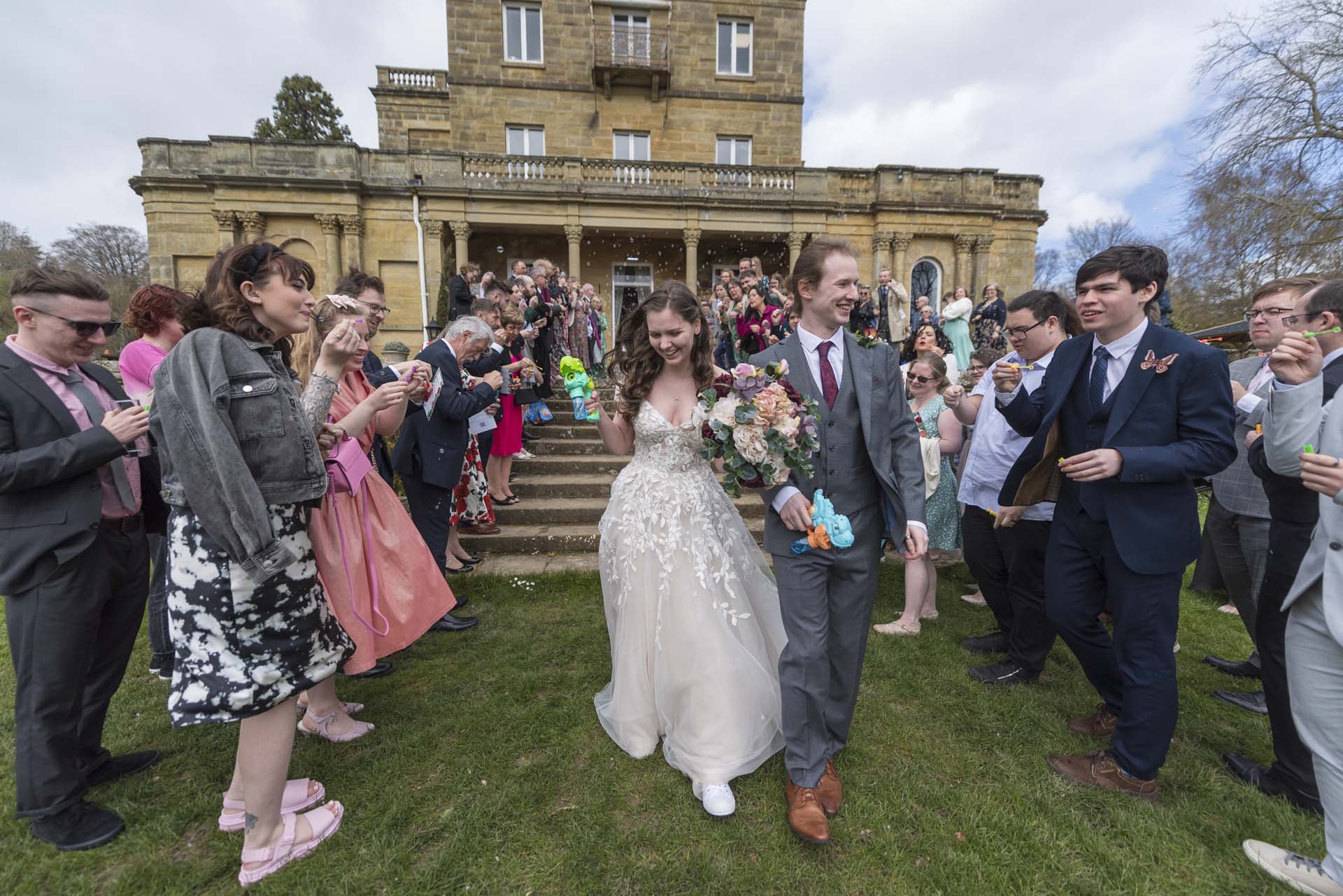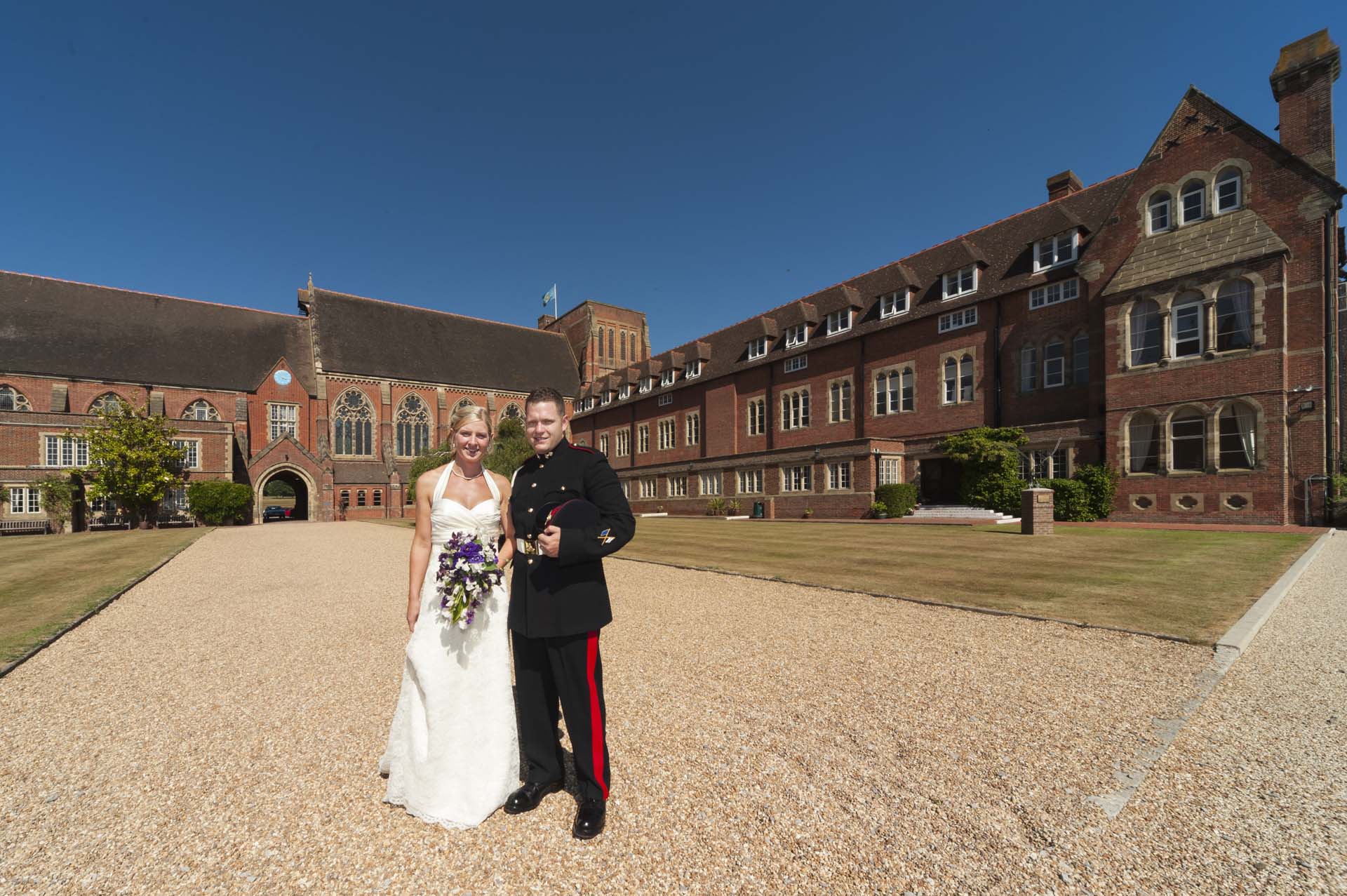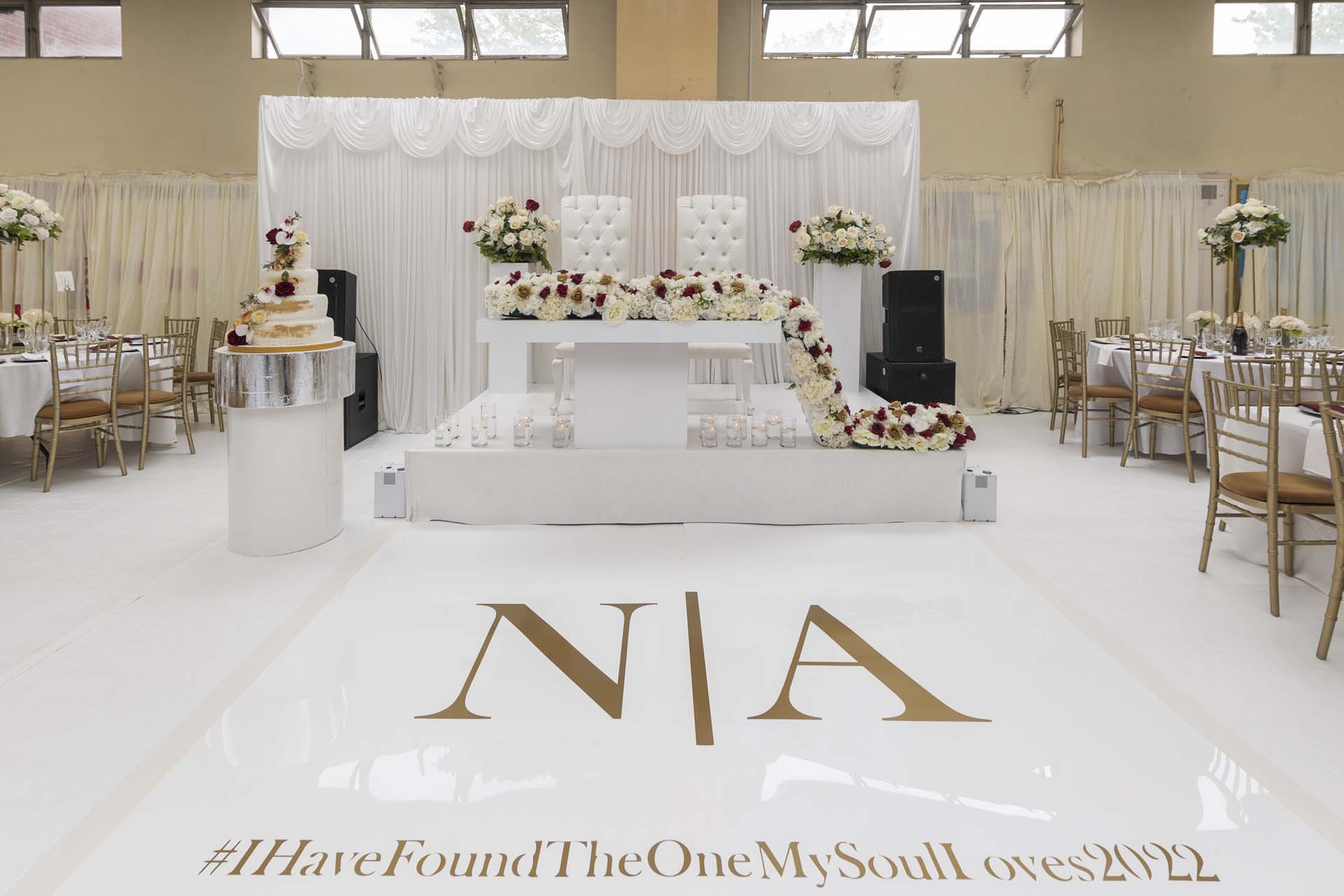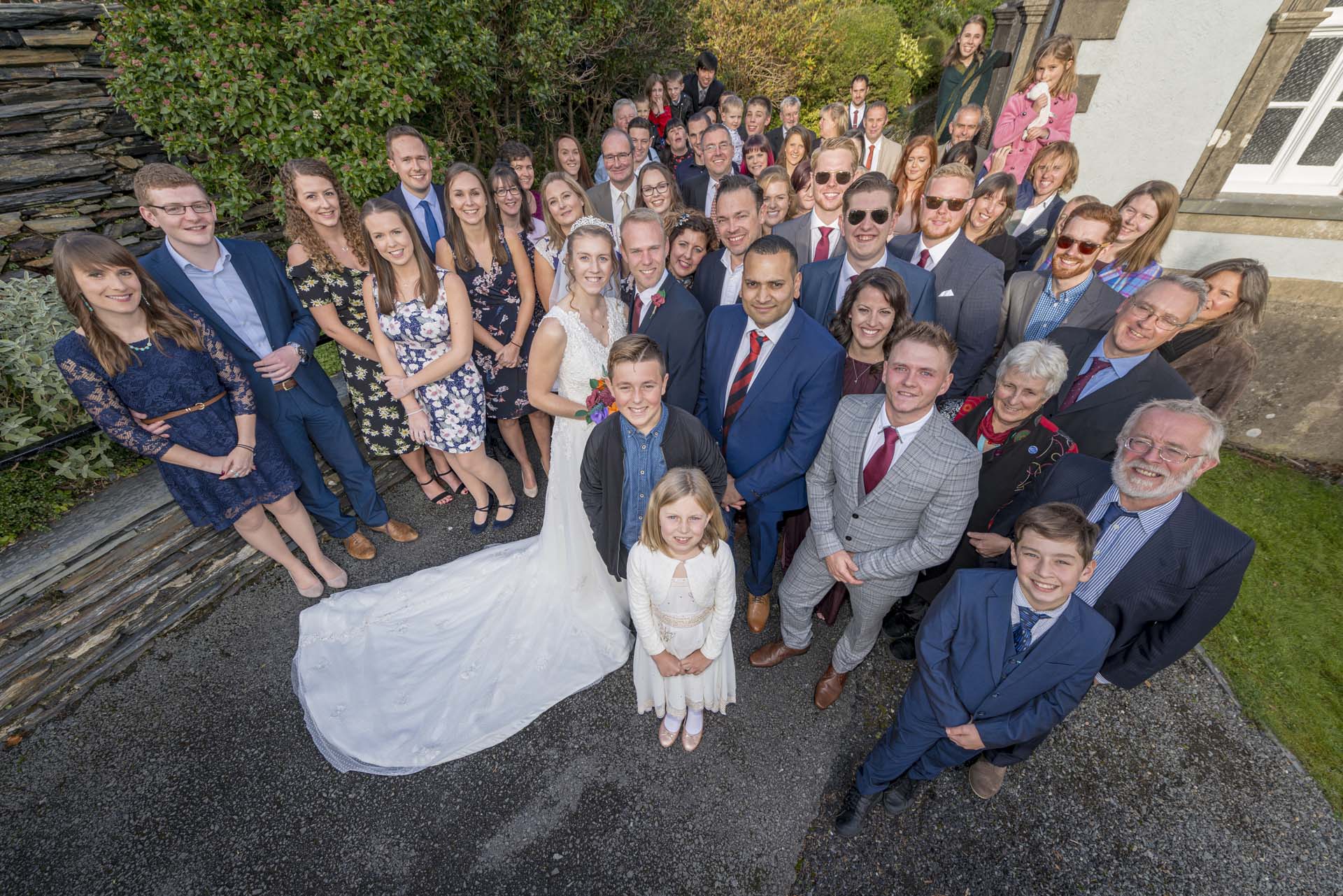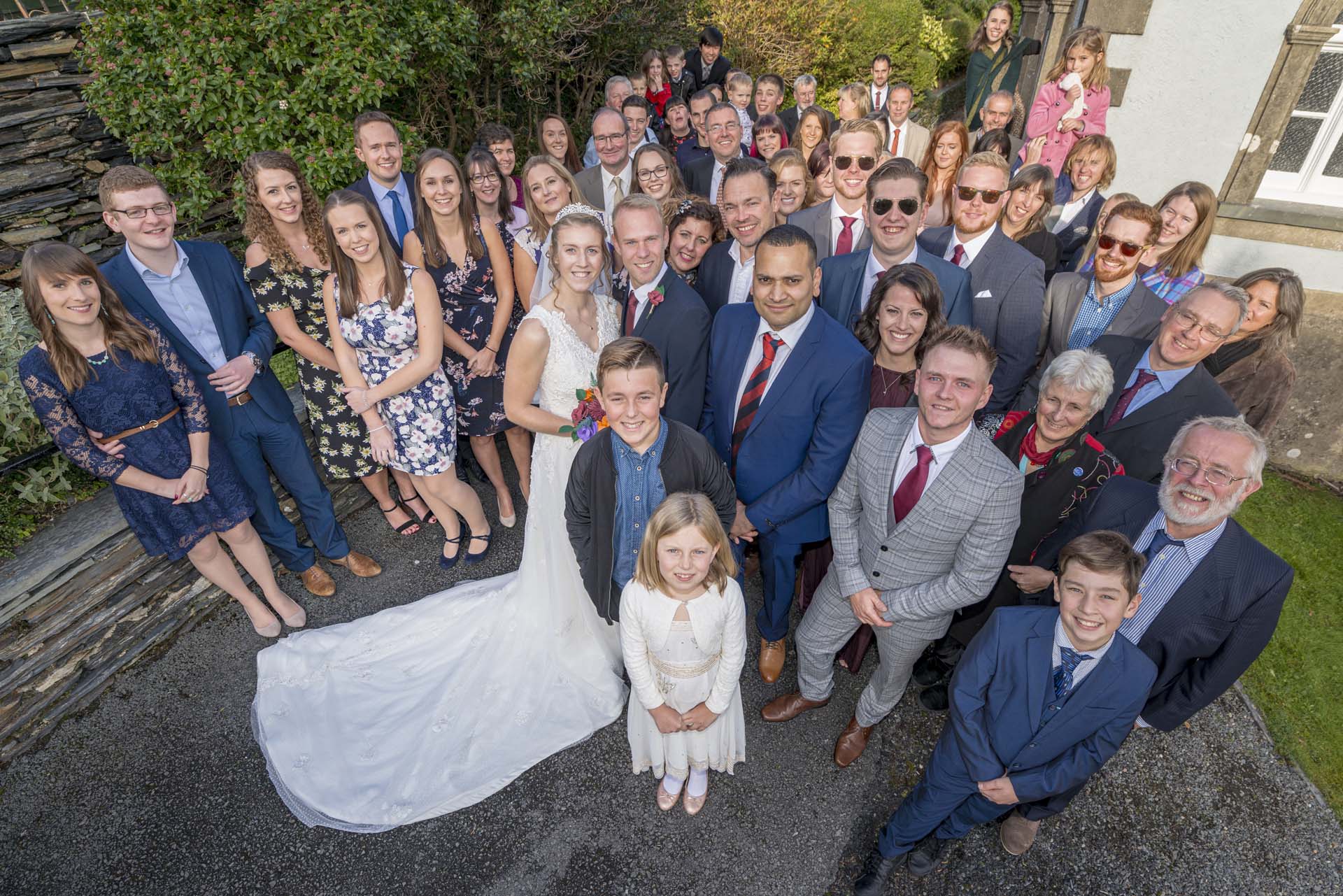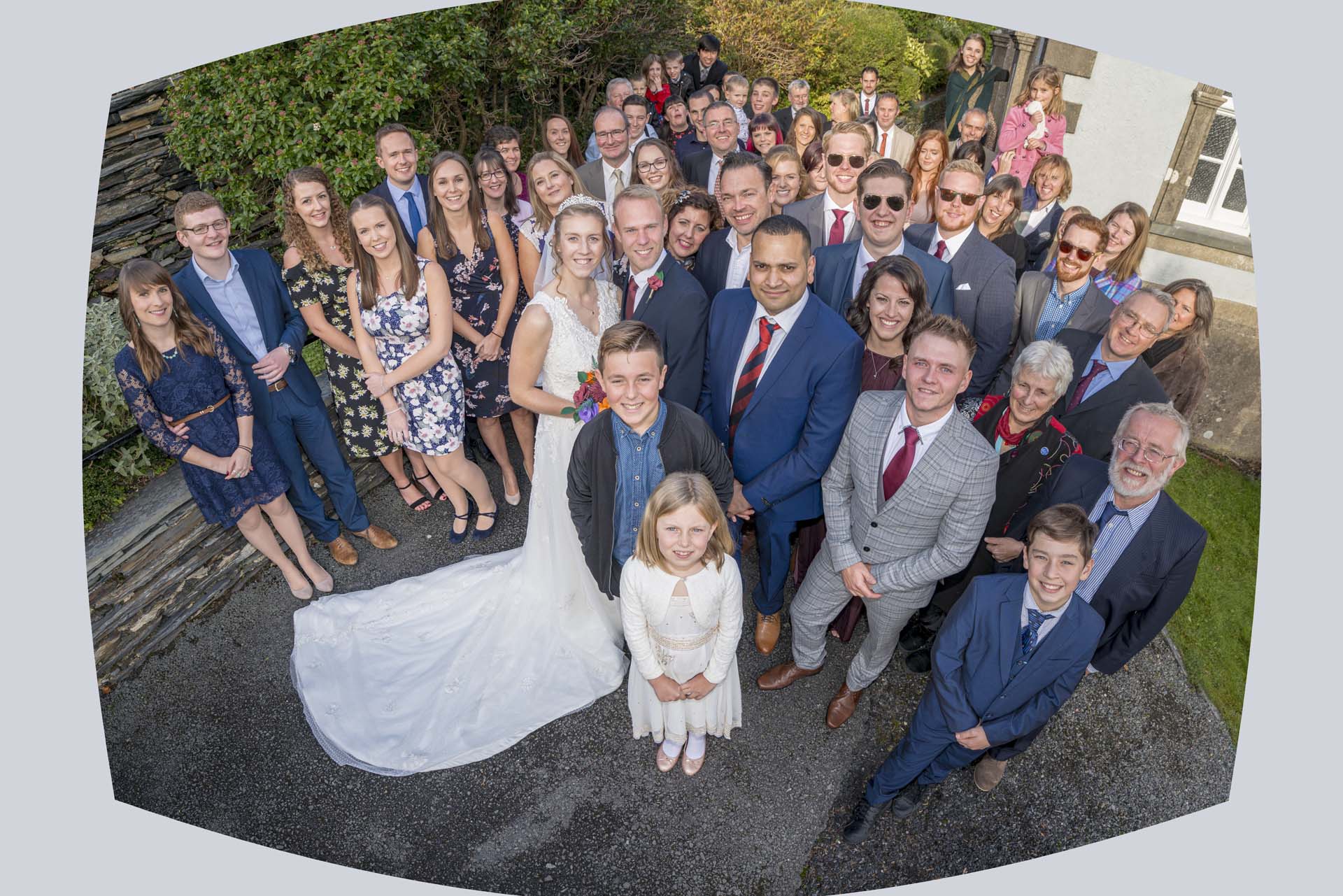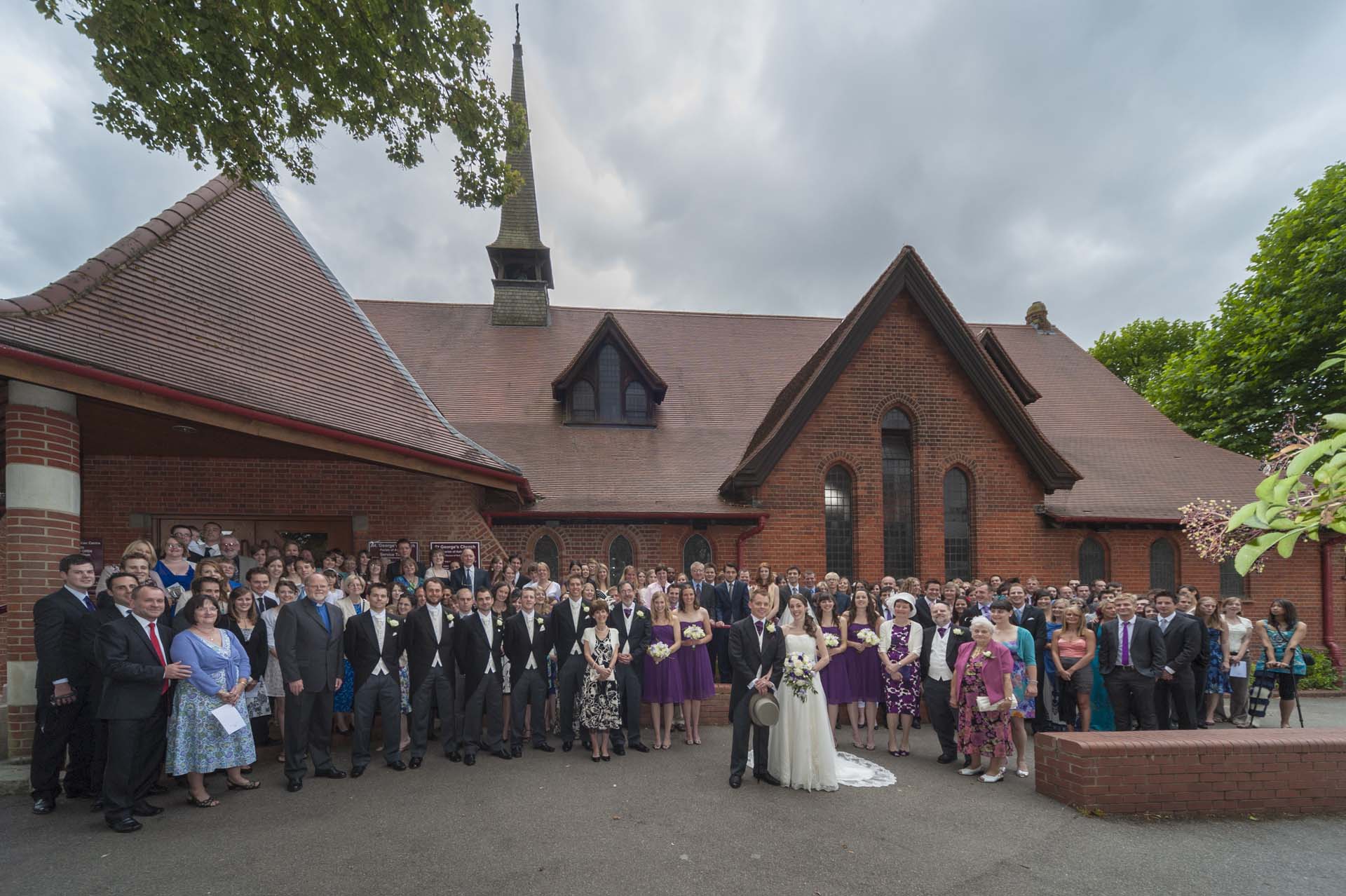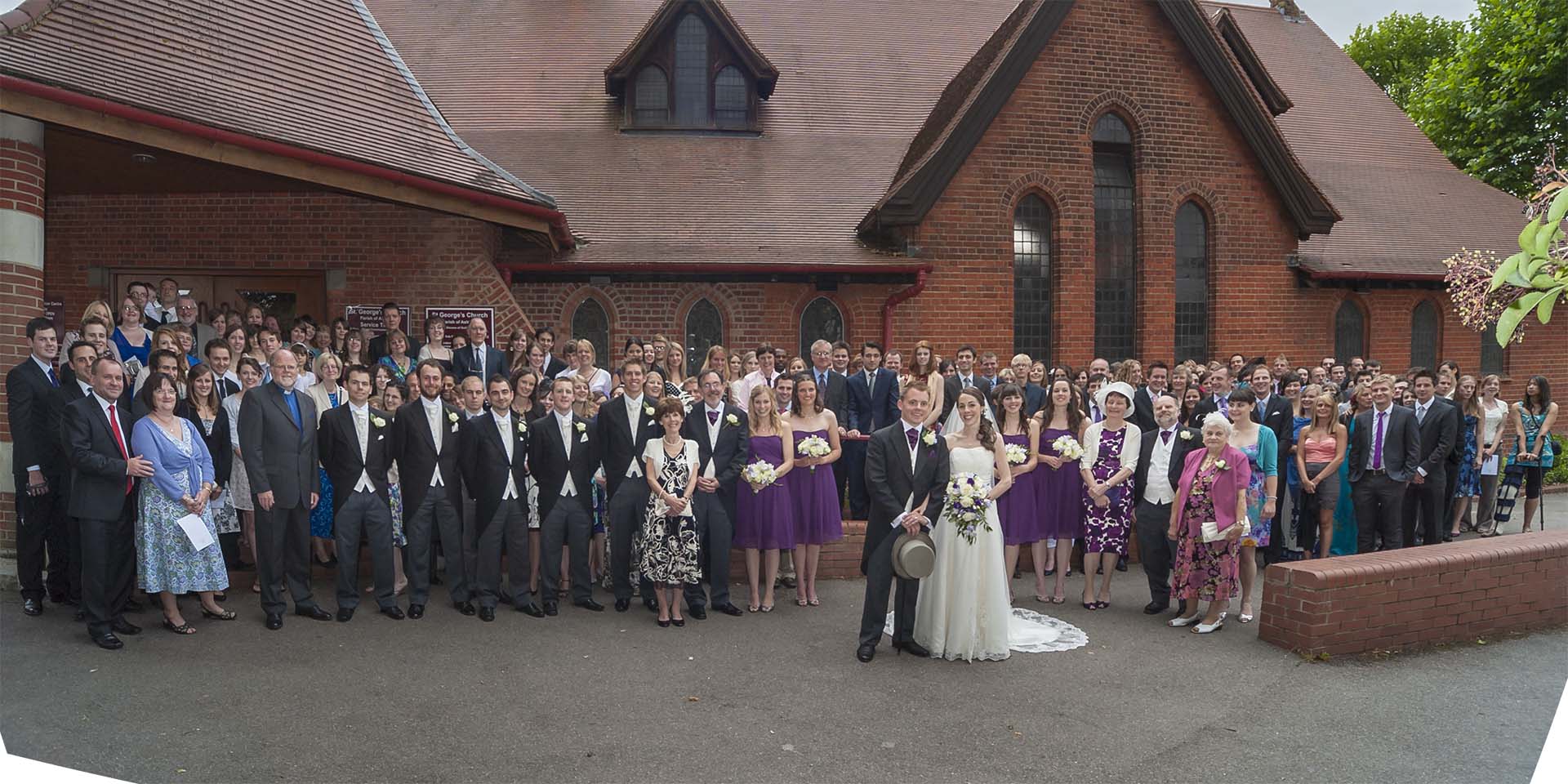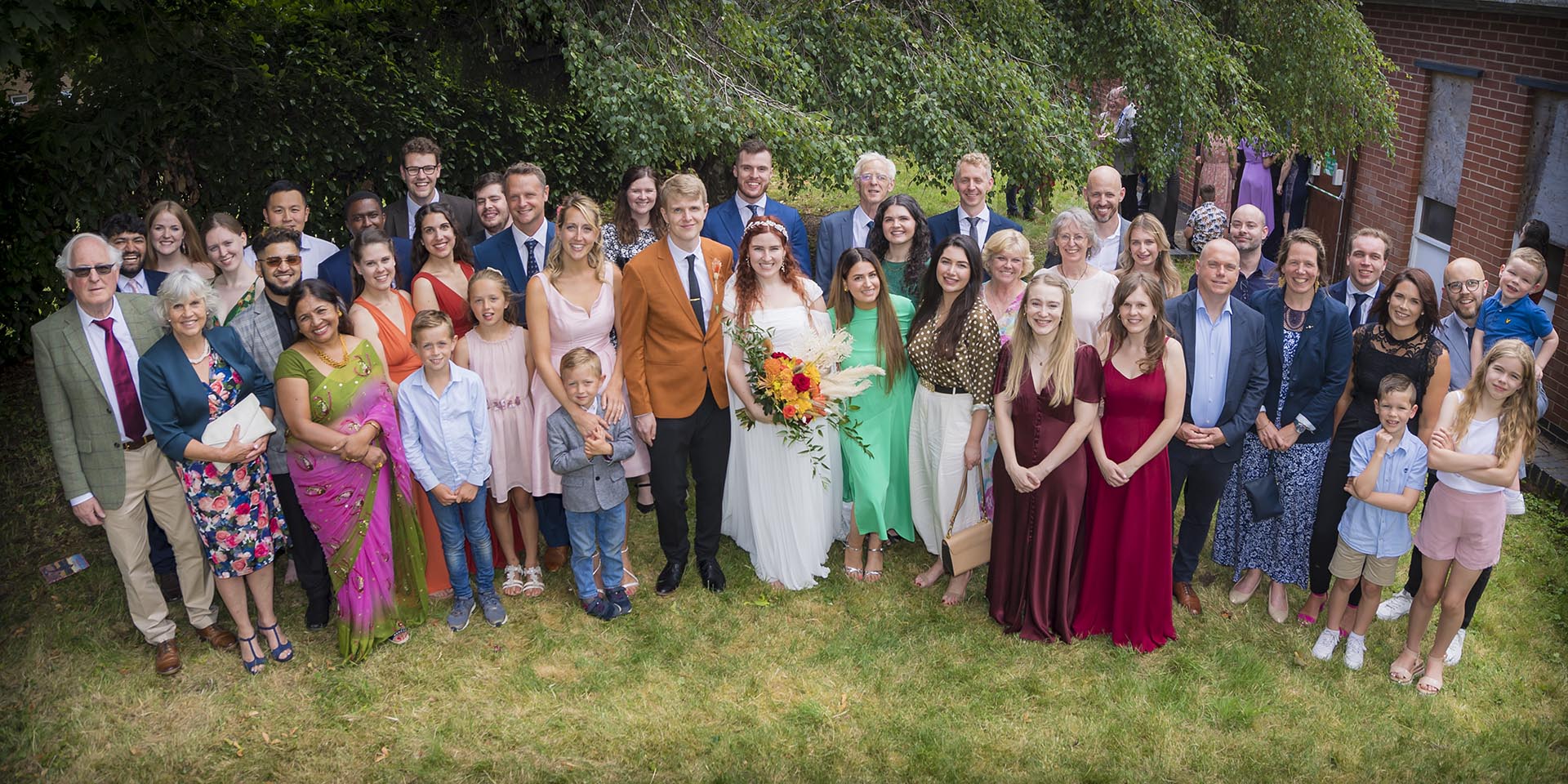A wedding photographer's tools:
Extreme wide angle lenses
What do I mean by an extreme wide angle lens?
Traditionally on 35mm cameras, “wide angle” meant any lens from around 40mm down to 24 or 20mm. By extension, extreme wide angle means lenses at 20mm or wider.
I am talking about rectilinear lenses here – lenses which keep straight lines straight in your picture. Fisheye lenses are also wide angle, and generally extreme wide angle, but they present different challenges and possibilities and I have dealt with them already. That article has examples of wide angle rectilinear lenses versus fisheye lenses, but as a refresher, here are two images of St George’s Church, Kemptown, Brighton. One is taken with my 12mm fisheye, the other with my 14-24mm zoom set to its widest (14mm) angle.
Rectilinear 14mm – significantly not as wide, but with straight lines showing as straight. Note, though, that because I am leaning forward to take the shot, the way vertical lines (like the pillars) seem to come together gives its own rather distorted look. Wide angle lenses are prone to give that type of effect.
It is the rectilinear kind of lens is the one we are looking at in this article.
Looking for a wedding photographer? Check out my portfolio pages, or click on the button below to contact me.
A wedding photographer's tools:
A few extreme wide angle lenses
Over the years as a wedding photographer I have owned a few very wide angle lenses. These three have always served me well – though the 10mm lens, as we shall see, is usually reserved for the most extreme situations.
In addition to the three shown here, I also own a Laowa 15mm f4 macro lens, but that is a bit of an outlier with its own specialised use which I will come back to another time.
The old Sigma 12-24 f4.5 – 5.6. When I bought this (secondhand) it gave the widest angle rectilinear view of any lens for a full-frame camera. It is also still one of the most cost-effective ways for a photographer on a budget to get a really wide lens, although other options have come out over the last decade or so. Vignettes when wide open, and not totally sharp to the edges, but stopped down a little it is a great lens. I sold mine to my son when I bought the Nikon shown here… I sometimes miss it.
The Nikkor 14-24mm f2.8. Together with the 24-70 and the 70-200mm zooms, this lens forms part of the essential trinity for pro photographers. I never go to a wedding without it – though I don’t expect to use it for nearly the number of photos that I do with the other two.
The three lenses in the “trinity” maintain f2.8 throughout their zoom range, making them great in low light. There are also very sharp. My only regret when I bought mine was that those 2mm longer focal length than the Sigma did noticeably reduce my angle of view. Which made me so pleased when Samyang/Rokinon launched the 10mm f3.5…
The Samyang 10mm f3.5 This lens (unlike the other two) is fully manual to focus, though this isn’t much of an issue with such a wide lens. It is wonderfully sharp and gives great results. It comes to every wedding, although often sees no use. Unless you know the venue, and how constricted some spaces will be, you don’t know if you may need a really extreme wide.
A wedding photographer's tools:
The challenges and disadvantages of extreme wide angle lenses at weddings
Extreme wide-angle rectilinear lenses need a lot of care in use. They don’t simply “get more in” – the perspective effects they generate can be extremely unflattering. A perspective that can be very effective in a landscape may be a disaster in a wedding shot. Check out the shots below…
The Glyder range from the summit of Tryfan – a classic extreme wide angle landscape. The way the clouds seem to “zoom” at you, or away from you, is very typical. To “map” such a wide scene on the sensor and keep the straight lines straight, the edges have to be “pulled” which creates that zoomy effect. There are few straight lines up mountains, of course, but if you know the two hills to the extreme left and extreme right here (Glyder Fach and Pen yr Ole-Wen) you would see that they have been stretched badly – they are steeper and thinner than you can see here.
Samyang 10mm
The clouds are too high above the church to show that “zoomy” effect, but check out the way the lens has s t r e t c h e d the people at either end of the group! The bride and groom look a little lost, while everyone on the nearer left hand side and even the distant extreme right looks like they should play in the front row of the scrum.
Sigma 12-24 @12mm
A wedding photographer's tools:
So how can you use extreme wide angle lenses at weddings?
The answer is… with care… and (sometimes) with tweaking. It is obvious that I always have my super wide angle lenses with me as a wedding photographer, and I do use them, with pleasing results. But you have to think, and be ready to use post-processing to give a more pleasing result.
Bridal preparations. I admit it isn’t often that the super wide lenses come out during this part of the day, but in a confined space and needing to get the whole of the dress in, they have their uses!
Bride getting ready at a cottage in the grounds of Polesden Lacey – wedding at St Giles Ashtead and the Freemen’s School
Nikkor 14-24 @18mm
During the wedding. I didn’t know this was planned, but during this Salvation Army wedding the bride and groom came forward to pray at the mercy seat while guests gathered round. I popped up onto the platform to get this straight down view. I like the shot, but it would have been so much better with the fisheye – it was this one photograph that forced that Samyang purchase!
William Booth College, Camberwell wedding
Nikkor 14-24 @14mm
During the signing of the register – often a chance to get a picture of the entire building with the congregation gathered. I was aiming for a good rectilenear perspective, with verticals vertical etc. Some of those young men have very long legs!
Ashtead, Surrey wedding at St George’s church
Sigma 12-24 @ 12mm
After the wedding. Sometimes rain or the threat of rain, or simply the presence of a gallery, makes it very natural to take a whole congregation group photo while still in the church. I think this was the latter – no rain but the couple wanted a record of everyone who had been there.
Dunstable, Bedfordshire wedding, at Christ Church
Nikkor 14-24 @ 16mm
After the wedding. Obviously wide lenses are useful for big group shots, if you are careful. This one is unusual – I know I could have been further back with a longer lens, but actually found the interaction with the group from close to very helpful. As it is this is the longest focal length in the set.
Camberwell, South London wedding, as in the prayer shot at the start of this row
Nikkor 14-24 @ 24mm
Confetti! That same wedding in Camberwell, I asked for the guests to gather around and above the bride and groom for the throw. I almost always use a wide angle lens – often my fisheye – for confetti, but generally try to have a second photographer also hanging back with a longer lens. In this case I threw caution to the winds so far as perspective distortion was concerned and just used the effect to get a sense of height and joy into the confetti throw.
William Booth College, Camberwell wedding
Nikkor 14-24 @22mm
Another confetti shot – only with bubbles! With the building in view, the fisheye was not a great idea, but then with the rectilinear the guests to either side are looking large! It is a trade off for me in this case – the dynamism and fun of the moment take precedence over perspective, and I hope I have good and flattering portraits of those guests anyway!
Wedding at Salomon’s Estate, Tunbridge Wells, Kent
Nikkor 14-24 @ 14mm
Bride and Groom portraits. It is very rare that I reach for the super wide lenses during the portrait shoot, but in this case the bride had asked for a photo of them both in front of the schol buildings, where she had been brought up as both her parents taught there. Obviously the couple are far enough from the camera to avoid any problematic perspective, and almost the entire building is in shot.
Ardingly, Sussex wedding, at Ardingly College
Sigma 12-24 @12mm
Reception venue. Often the couple want images of the reception venue before the hordes descend. A good rectilinear approach is generally needed. For this Anglo-Ghanaian wedding I wanted to get in the high table and the words on the floor in front of it.
Edmonton, North London wedding, at Edmonton Baptist church
Nikkor 14-24 @ 14mm
A wedding photographer's tools:
How to tweak extreme wide angle shots in post-processing
It is obvious that extreme wide angle lenses have their uses in wedding photography but also their limitations. However, it is often possible to tweak the images in post-processing to reduce some of the less pleasant features and to get a more balanced result.
In effect, this is the opposite of the “defishing” I wrote about in the article on fisheye lenses. Starting with a rectilinear image, I actually make it more “fishy”, reducing the stretched legs and massive people on the edges of the frame. Here are a couple of case studies:
Here is the original image of a wedding group, shot with the Nikkor 14-24 at 14mm. It is ok, but look at the perspective on the left and right sides of the picture – especially the young woman on the left. There are few straight lines in the image, so adding some “fisheye” is not going to look disturbing.
Penrhyndeudraeth, North Wales wedding
Using the sliders in the “optics/manual” section of Photoshop’s raw Camera Interface, I have created some pincushion distortion. This has the effect of pulling the bride and groom forwards, making them relatively larger, and reducing that “zooming” effect on the guests near the edges. This is the version as I would deliver it.
As an alternative to using the Raw Interface, Photoshop proper has a built-in correction for very wide lenses – under filters. This is also controllable, though if you give it its head it can produce a result like this. You couldn’t crop this to lose the white “frame” without chopping off heads or feet, so it is probably a no no – but it does show you what a natural look can be achieved if you compensate fully.
If I abandon that straight roof line and pull the lens optics in a fisheye direction I can get a far more pleasing scaling for all the guests, with the bride and groom less “lost” in the depths of a large picture. But (as with the filter image above) this kind of stretching has resulted in white areas – parts of the photo which simply don’t exist. By not going too far, though, I have kept those little triangles small and in areas where I know I can easily fill them in on the PC…
… giving me this result. Despite some straight lines in the shot, it doesn’t look painfully fisheye, the white areas have gone and we have a pleasing perspective on everyone.
The only problem, as ever, with extreme wide angle lenses, whether rectilinear or fisheye, is that people really don’t believe that they are in shot! This is the problem with the woman on the extreme right – she thinks she isn’t in the photo. Oh well…
A wedding photographer's tools:
I love my wide angle lenses!
When I was young, I was obsessed with telephotos. I don’t think I was alone in that – bringing distant objects closer was a goal for other young photograophers, especially when it came to sports. Gradually we learned that long lenses are about perspective as much as they are about magnification. And then we learned that wide – seriously wide – lenses also have a role to play.
Good quality extreme wide angle lenses aren’t cheap, any more than long lenses are. But they are an essential part of a professional wedding photographer’s toolkit. I will leave you with this from the Nikkor 12-24, set at 18mm, just last weekend at a stunning wedding in Coventry.
I hope the blog has informed and entertained! If you are looking for a photographer for your wedding or other special event, please don’t hesitate to contact me via my online form or email. You can text me on 07983 787889 or email me at Andrew@AndrewKingPhotography.co.uk
Photos © copyright Andrew King Photography

